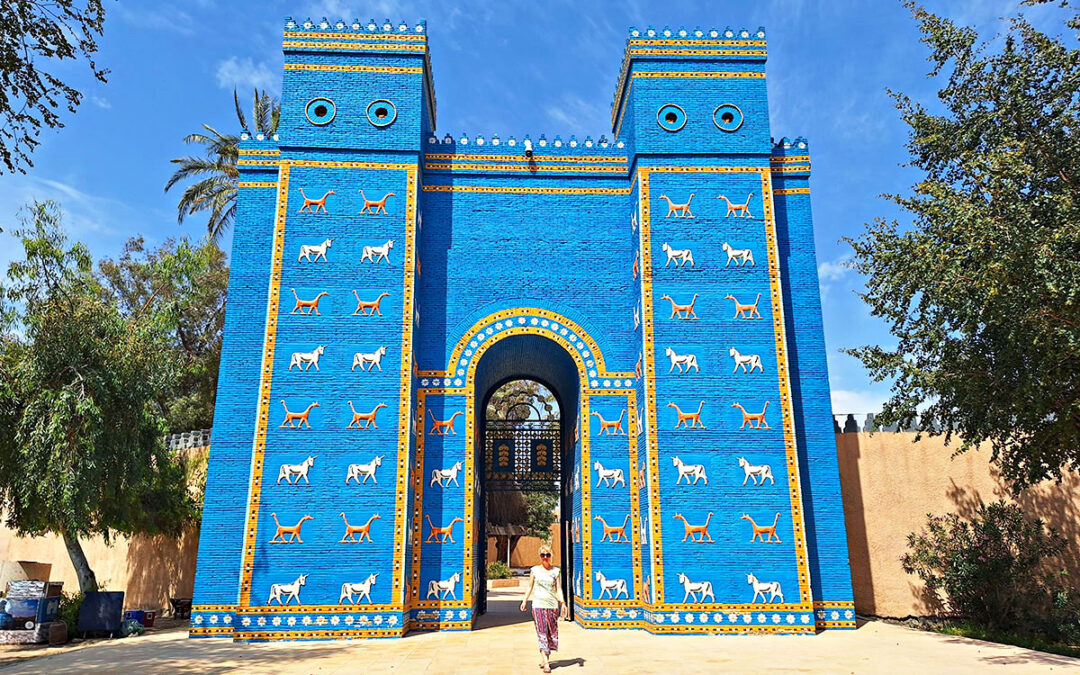Iraq is mostly known as a dangerous, demolished country, stained with blood from the countless wars of the recent years, starring ISIS, Saddam Hussein and the USA. The media usually promote it as an ugly country full of ruins, debris and locals-terrorists, posing with a gun on one hand and a bomb on the other. But, what about the oldest civilizations in the world, the Sumerians, Akkadians, Babylonians and Assyrians, the fertile land of Mesopotamia, Alexander the Great who conquered, lived and died in Babylonia, the Hanging Gardens of Babylon, the Biblical Tigris and Euphrates rivers, Baghdad of Halima’s tales, the hidden gems shrines of the Holy Muslim cities, and the ancient history of our school books?
My trip to Iraq was delayed for 2 years. My plans didn’t work out the way I wanted that time, so that year I replaced it with Syria. Last April though, everything came in handy and I found myself wandering around Federal Iraq alone for 12 days, following 5 days around the Iraqi Kurdistan.
My epic adventure started from Istanbul to Kuwait by plane. From there, I crossed the Kuwait-Iraq land border and visited Basra, Nasiriya, the Mesopotamian marshes, Diwaniya, Babylon, the holy cities of Najaf and Karbala, ending up in the capital Baghdad.
All those days I experienced unforgettable moments, I was hosted by families, met amazing people, tried local delicacies, I hitchhiked, traveled by buses & shared taxis and visited ancient cities and beautiful temples. I even experienced for the first (and last, I hope) time in my life, the horror of war, when suddenly around midnight and while relaxing at my hosts’ place in Babylon, an Israeli rocket passed over our heads and landed on an Iranian base 10 km away, causing a huge explosion and troubles to the locals. It was actually those days in April, when the tension between Iran and Israel had peaked, once again.
Baghdad felt like it was straight out of the Middle Eastern folk tales “1000 and 1 nights”, and I loved it for no particular reason! I was enchanted by the unique sunset over the Tigris River, the numerous bazaars, the beautiful neighborhoods with their colorful graffiti, the impressive Shiite temples, and the old, wooden, destroyed houses of the old city center. Sure thing, I will never forget the strong smell of the Arabic coffee with cardamom I was enjoying every day in their cozy and unique traditional coffee shops, together with the lovely people of this country!
I passed by the town of Samarra, with the impressive minaret which was unfortunately closed, but thankfully, the similar yet smaller Abu Dulaf minaret was free and open to visit, just 20km away. Tikrit and Mosul next, the two legendary cities destroyed by ISIS, having left walls full of bullet holes and ruined houses. Indeed in Mosul, you still walk on corpses buried under the collapsed buildings, while the stones are painted red as a reminder that one wrong step can be fatal! From there, I continued to Iraqi Kurdistan, Turkish Kurdistan and finally back to Istanbul.
The landscape of the country did not impress me like in other countries of the region, but the Iraqis were the biggest surprise and won me over from the first moment I set foot on the border! I have no words for the kindness, hospitality and sense of humor of these people!
Starting with my friendly hosts, the random people who were asking about my name and nationality, the vendors who didn’t let me pay for anything, the taxi drivers who didn’t accept money, the policemen who were willing to help me anytime, the soldiers at the check points who were joking about my Arabic skills, the local travelers on the buses who were constantly inviting me home; everyone was kind, hospitable, respectful and made me feel safe in this long-suffering country, from the first moment.
This trip exceeded my expectations! It’s now a part of those special ones, that when you return, you miss everything and nothing is the same anymore. You forget the hard moments, the anger, the difficulties and simply miss the people you’ve met, the smells, the tastes, the music, but above all, the feelings you had while there!
I departed Mesopotamia leaving behind a piece of my heart, and I brought unforgettable memories and that delicious Arabic coffee with cardamom.. this way I’ll keep on dreaming of my endless walks around fascinating Baghdad with Shahrazad and Aladdin, listening to the enchanting Arabian music!
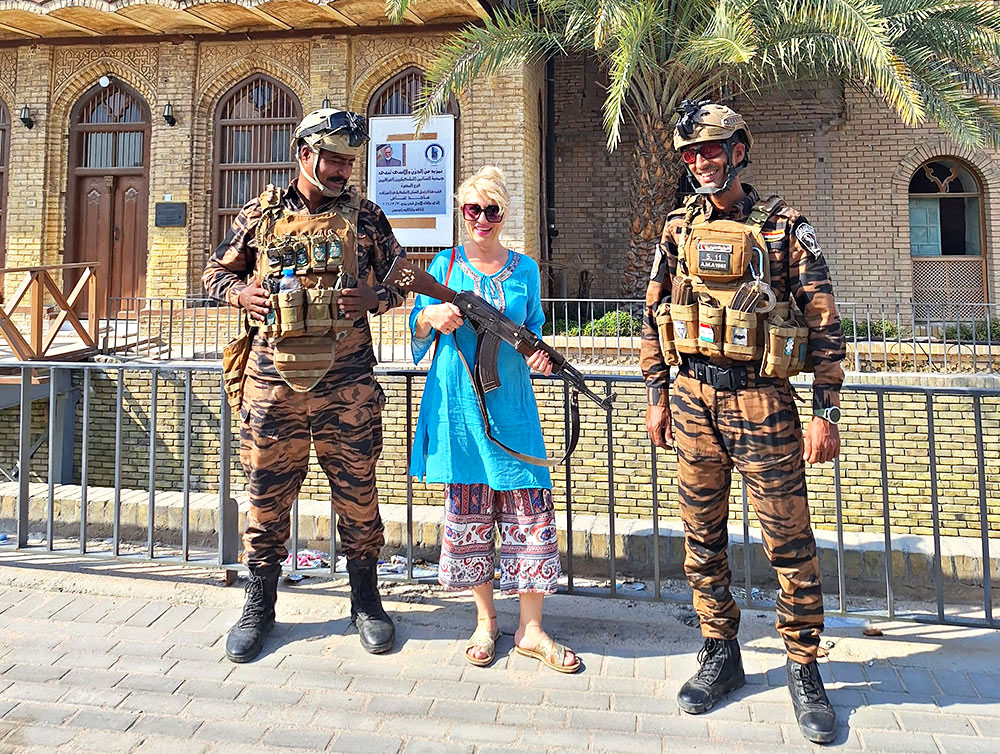
BASRA
Basra was my first stop coming from Kuwait. I arrived late at night and was hosted by locals who showed me around the city the next day. Its location near the Persian Gulf and the oil fields of the wider area makes Basra the richest city in Iraq, first thing you notice from the moment you arrive, due to the reconstruction and the luxury cars on the streets! There is no actual tourist interest here and it is visited mainly by businessmen and travelers arriving from Kuwait.
Points of interest in Basra:
- The old town and the buildings of the unique architecture with the wooden balconies, which unfortunately have remained abandoned and damaged
- The promenade (Corniche) on the river Shatt – Al Arab
* I was hosted by locals for 1 night and moved around by private car
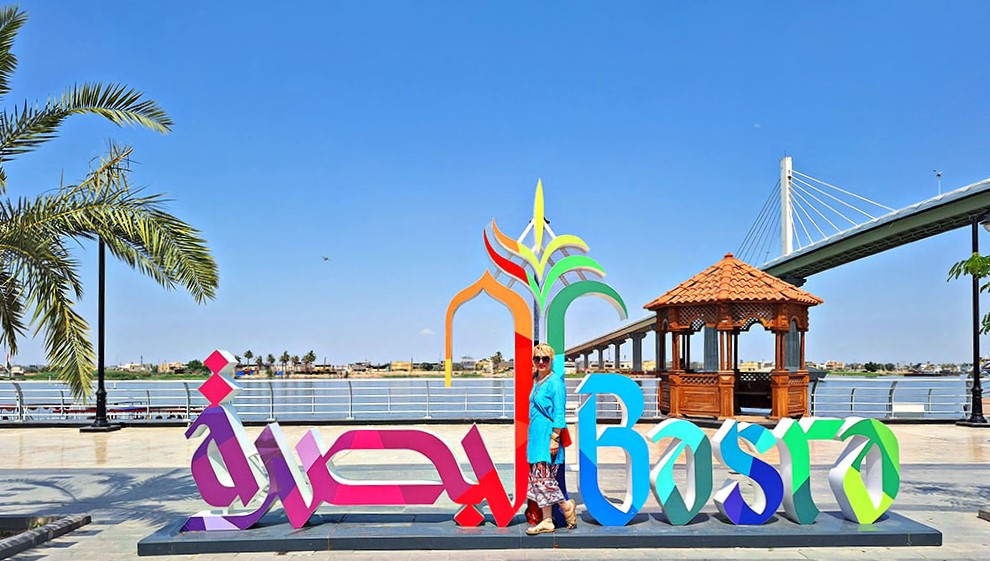
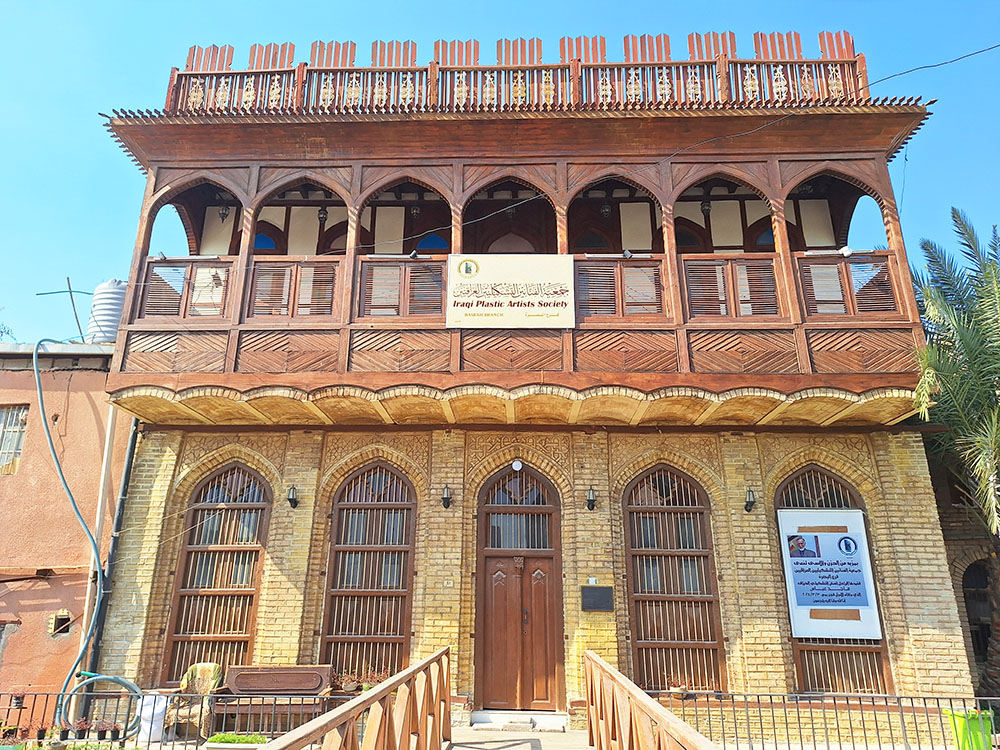
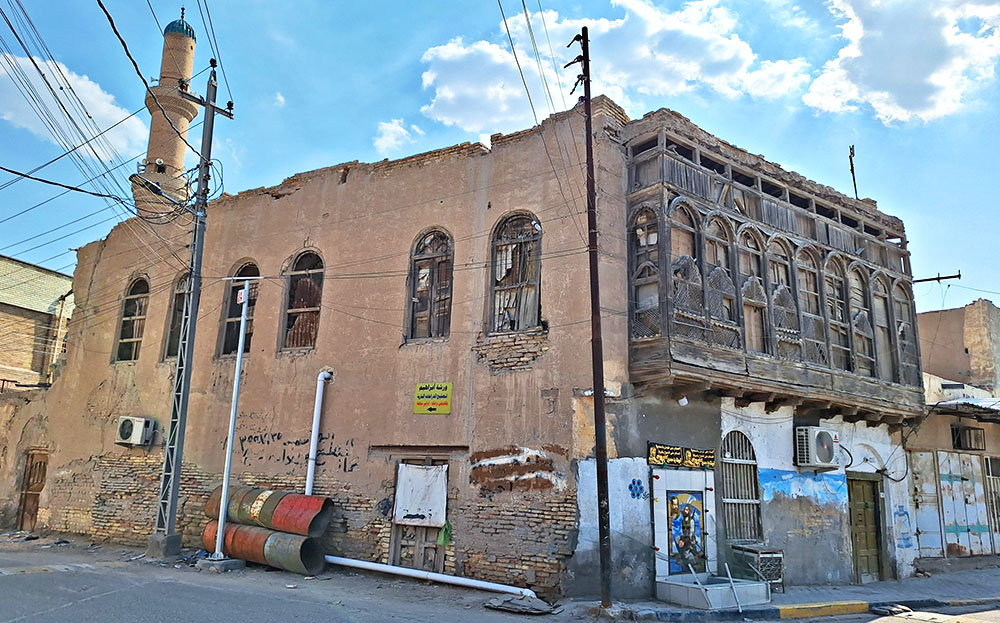
NASIRIYA – UR TEMPLE – THE MESOPOTAMIAN MARSHES
Nasiriyah is known mainly because of its location on the banks of the Euphrates River, near the ancient city of Ur, which is also the main attraction of the area. The great ziggurat of Ur is the best preserved of all the temple complexes built by the Sumerians, known in the Mesopotamia region. Private transport is required to visit the ancient city, since it is located in the middle of the desert, west of Nasiriyah.
Another interesting part of the wider region is the wetland of the Al-Chibayish province, the land of the Marsh Arabs. Known as the Madans, one of the most ancient communities of Mesopotamia who have developed a unique culture closely linked to the landscape, they have lived in the marshes and still are living around, among tributaries, lagoons and canals, while some villages are built in artificial islands of mud, burl and reeds. Their main occupation is reed and rice harvesting, fishing and water buffalo herding. The draining of parts of the swamps that began in the 1950s and continued into the 1990s during Saddam Hussein’s presidency to reclaim land for agriculture and oil exploration, had the effect of displacing many of these local residents. After the American overthrow of Hussein in 2003, the swamps have partially recovered and the Madans are trying to return to their “homeland” keeping their traditional way of life.
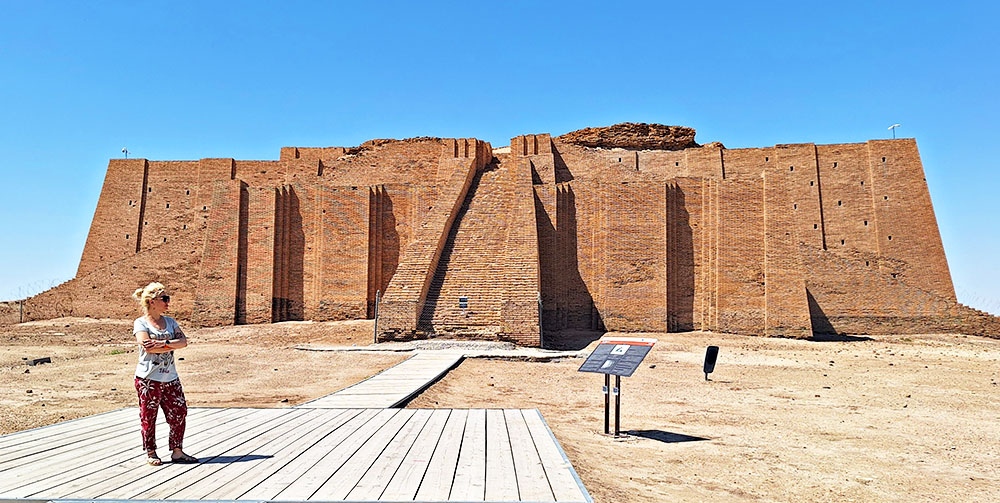
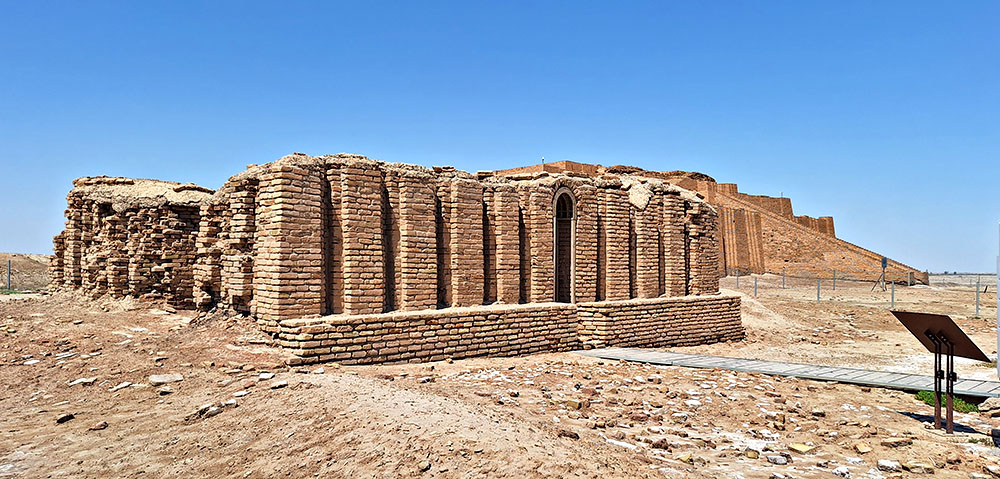
Ziggurat Temple of Ur
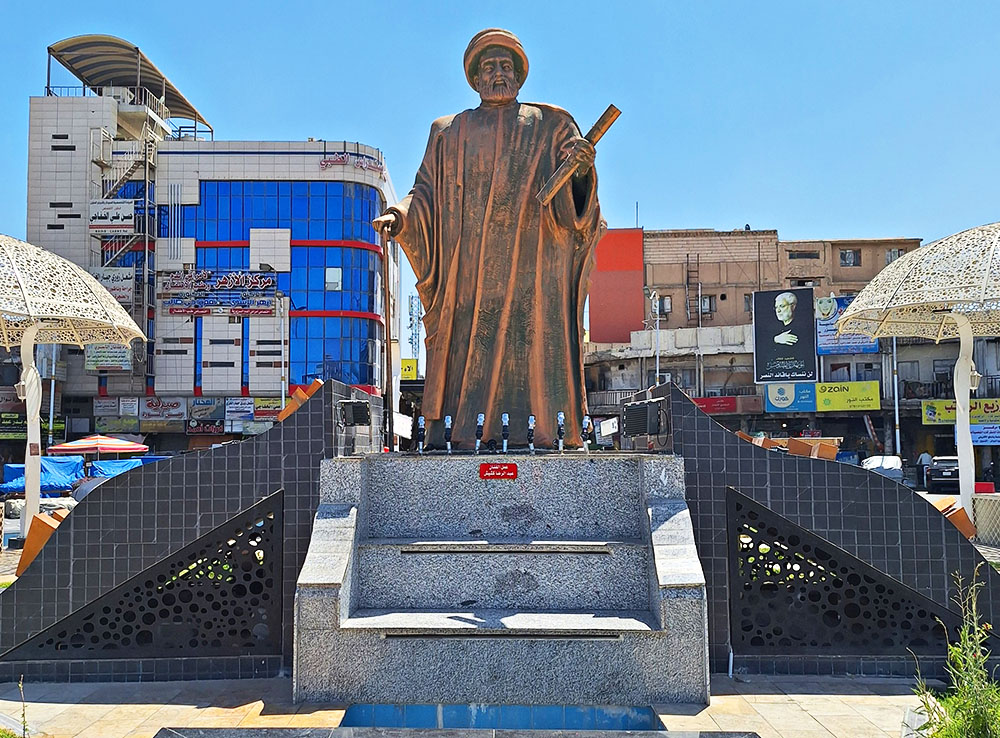
Nasiriya
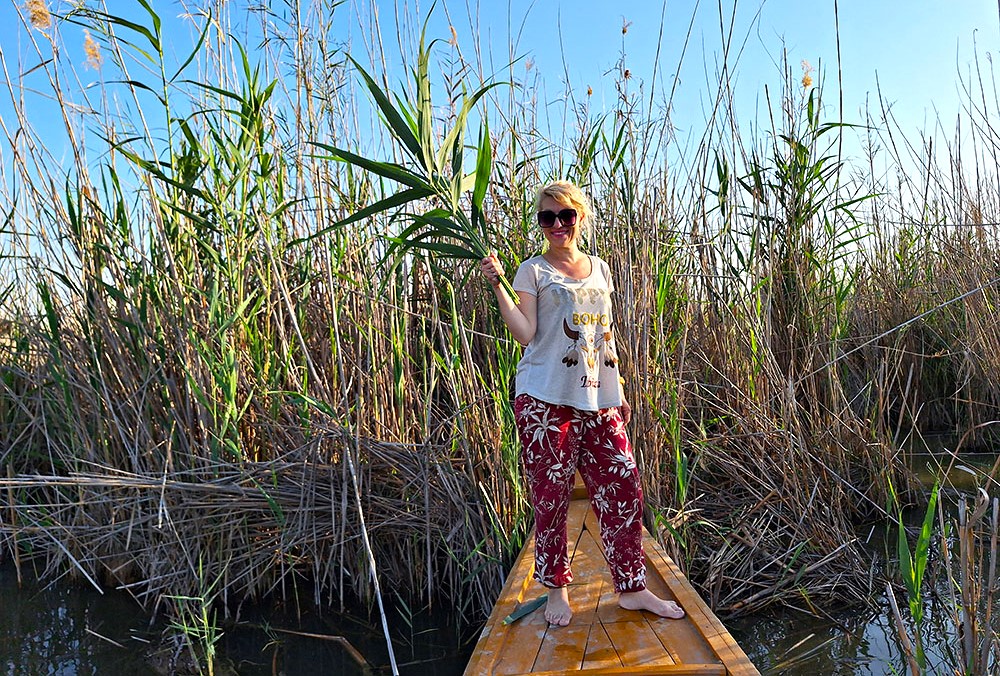
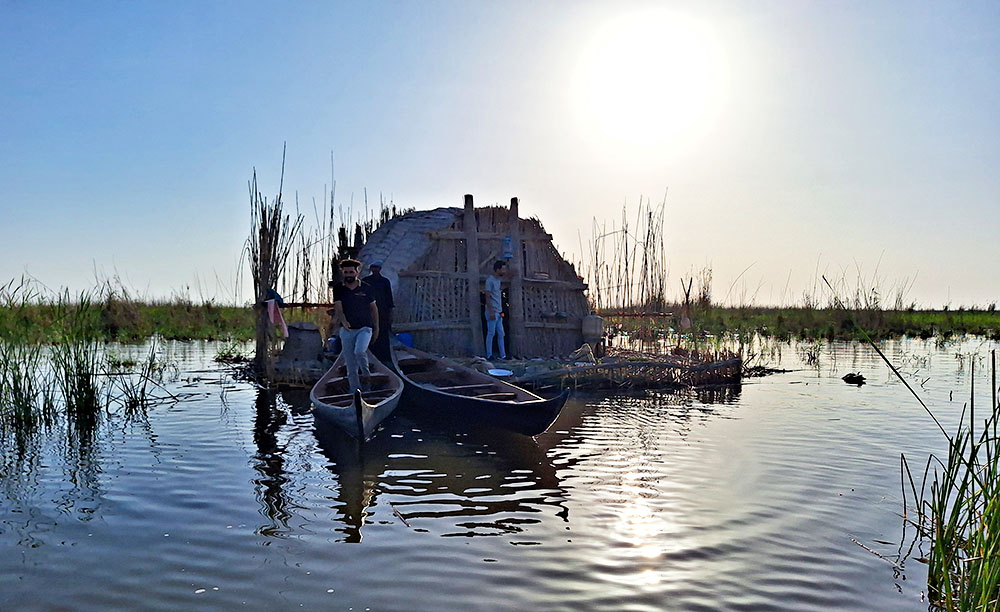
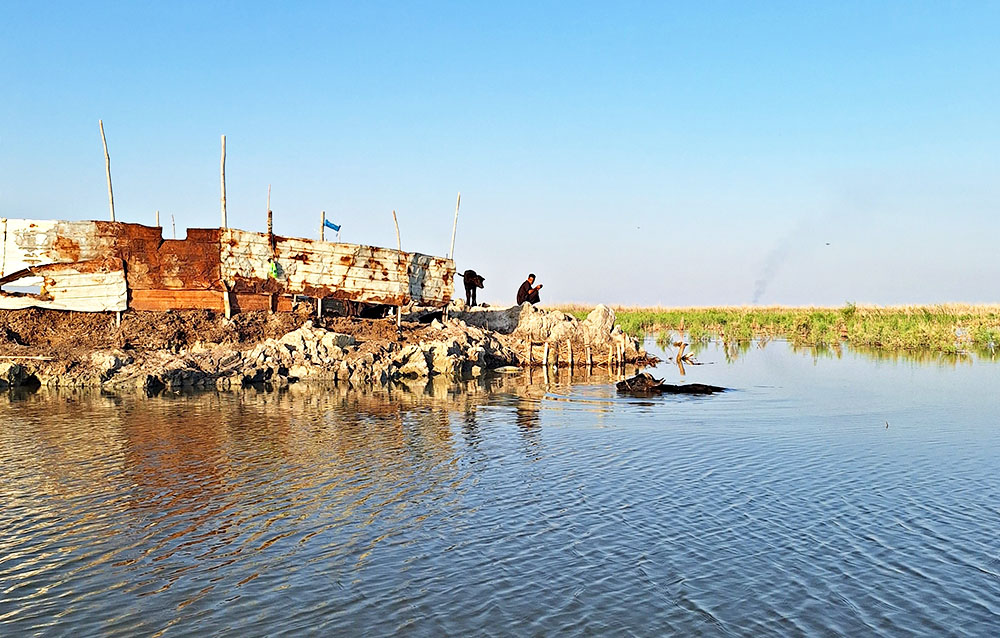
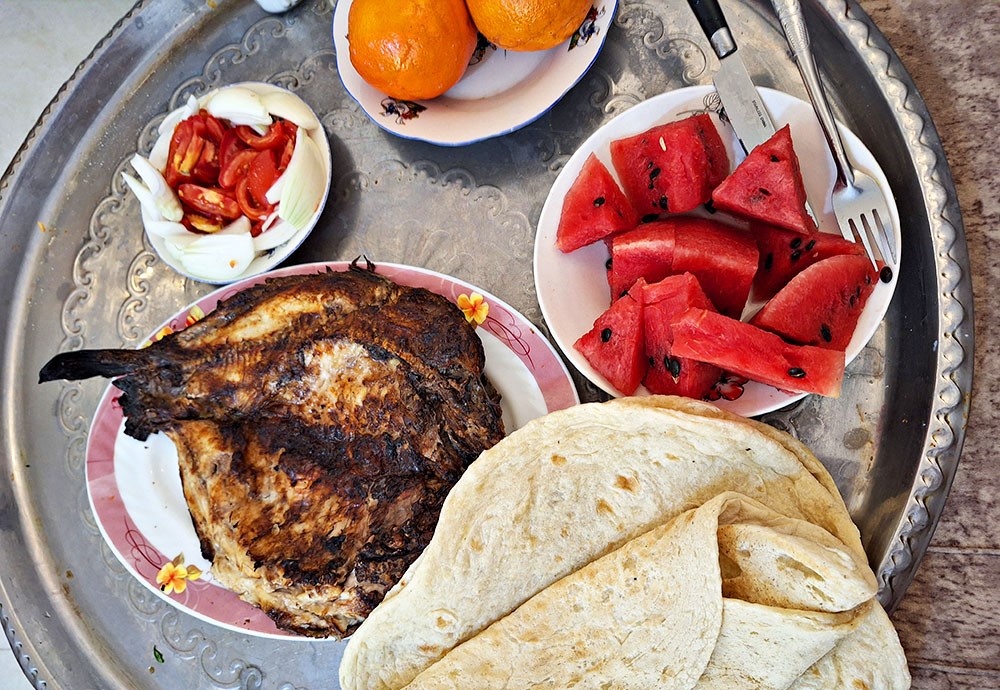
the Mesopotamian marshes
Points of interest in the area:
- Nasiriya city center
- The ancient city of Ur and the Ziggurat Temple of Ur
- Iraq’s largest prison Al Hoot, in the middle of the desert between the town and the temple of Ur
- The 40’ boat ride around the Mesopotamian marshes, by a traditional pirogue
* Entrance fee to the archaeological site of UR: 25,000 IQD
* Price of the boat ride and dinner with the local fish Masgouf: 35,000 IQD
* I was hosted by locals, 1 night in Nasiriya and 1 in Diwaniya on my way back from the marshes
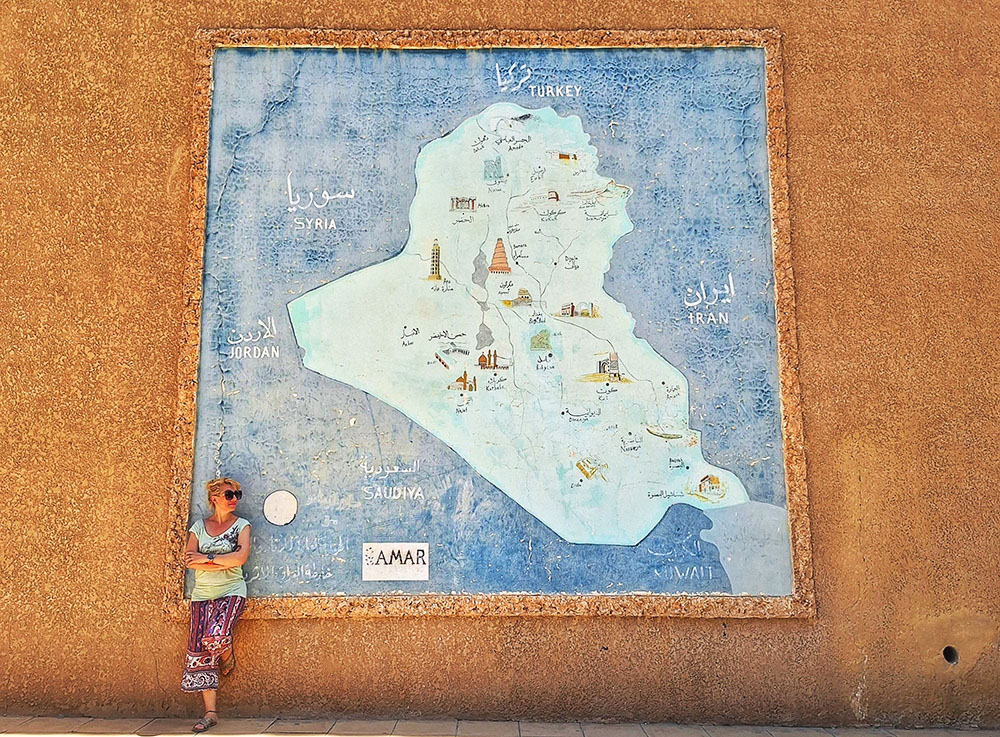
ANCIENT BABYLON
Babylon, the famous city that for centuries was the capital of the ancient Babylonian state, was built on both banks of the Euphrates River. Known for its hanging gardens, the Tower of Babel, the palace of King Nebuchadnezzar, but also as the last place of residence of Alexander the Great, the archaeological site is located north of the town of Hela and is open to public during the daytime. The Gate of Ishtar, the blue entrance to the archaeological site is a replica, its upper part is on display in the Pergamon Museum in Berlin, and parts of it can be found in many museums around the world, as well as in the National Museum in Baghdad. Apart from part of the walls, the lion statue and the ancient theater, no other monuments have survived and the archaeological site is mostly empty.
Just right behind the ancient Babylon, one of Saddam Hussein’s palaces is built on the neighboring hill, overlooking the archaeological site on one side, and the valley of Mesopotamia and the Euphrates River on the other. The palace is abandoned and damaged, but can be visited without an extra fee and its entrance, which is guarded, is located behind the ancient city.
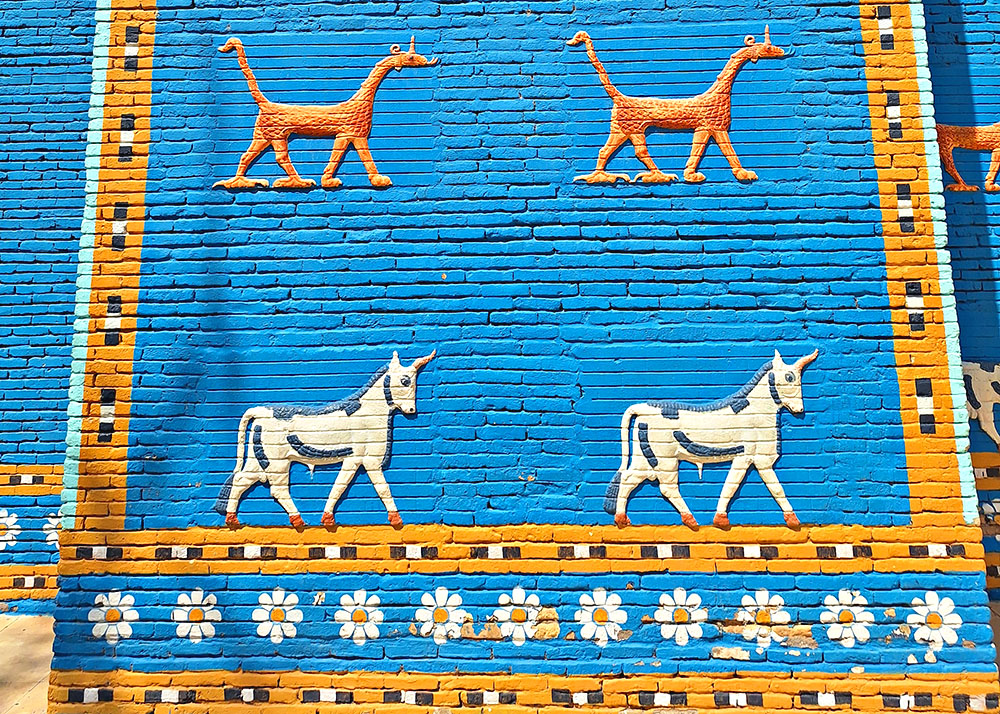
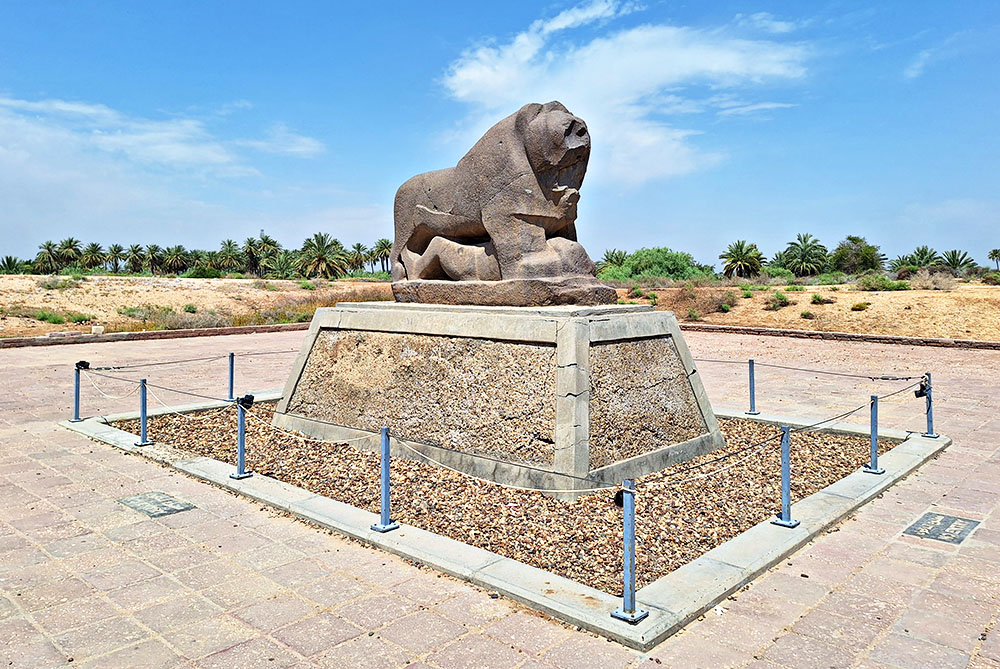
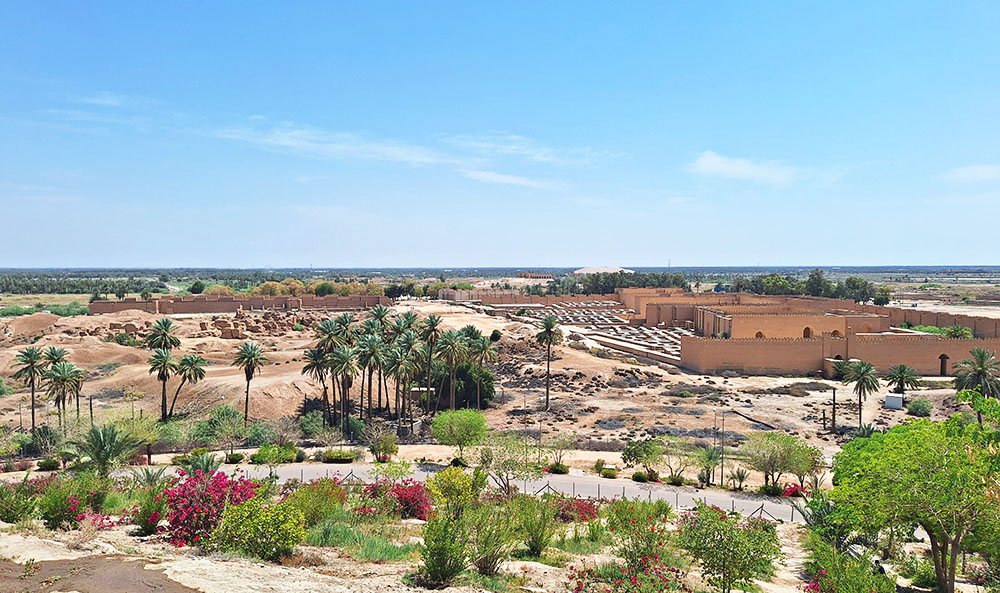
Views to the ancient Babylon from the Palace
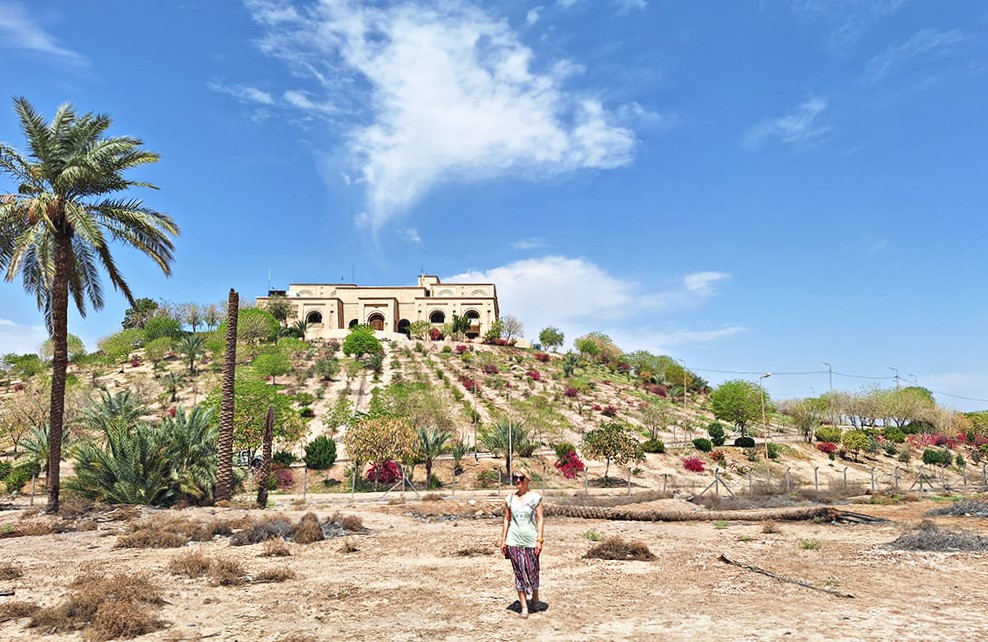
Saddam Hussein’s palace from Babylon
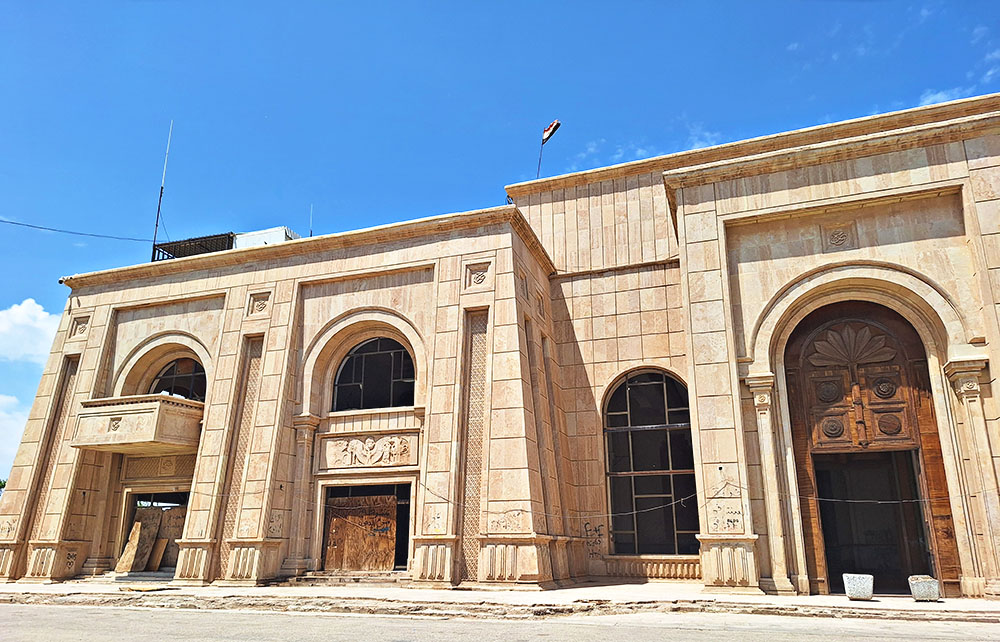
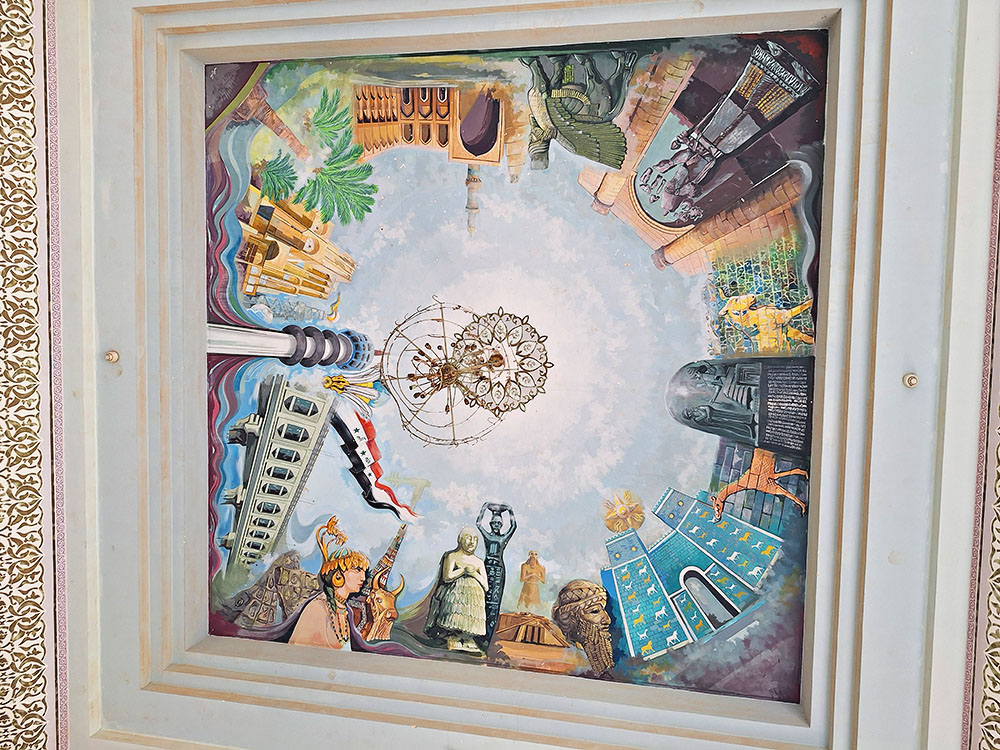
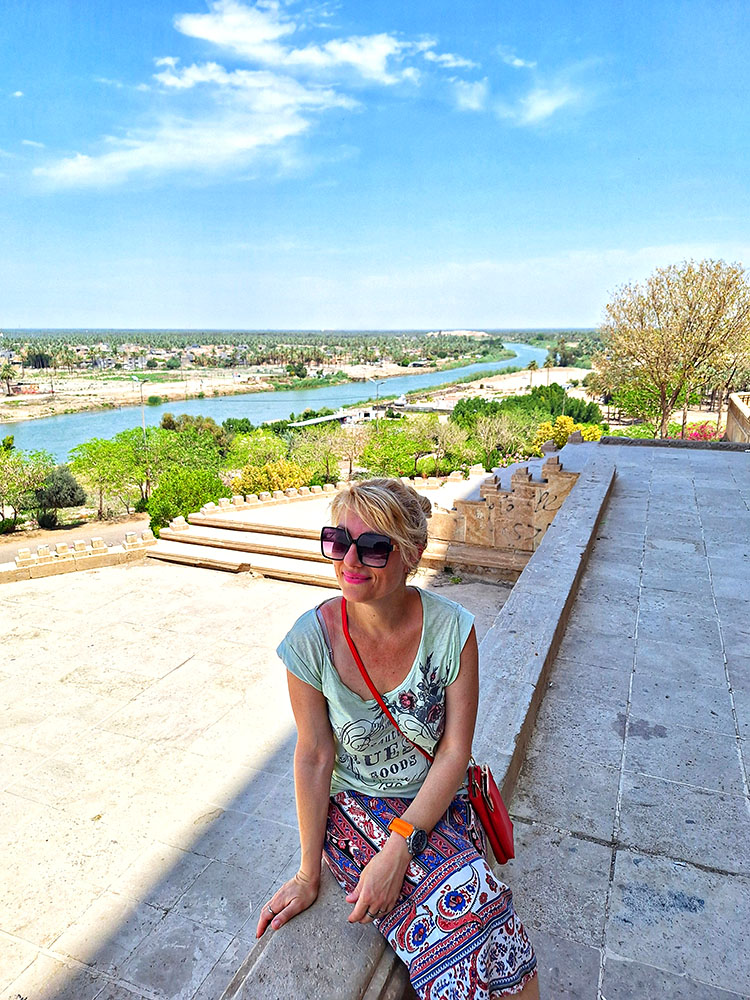
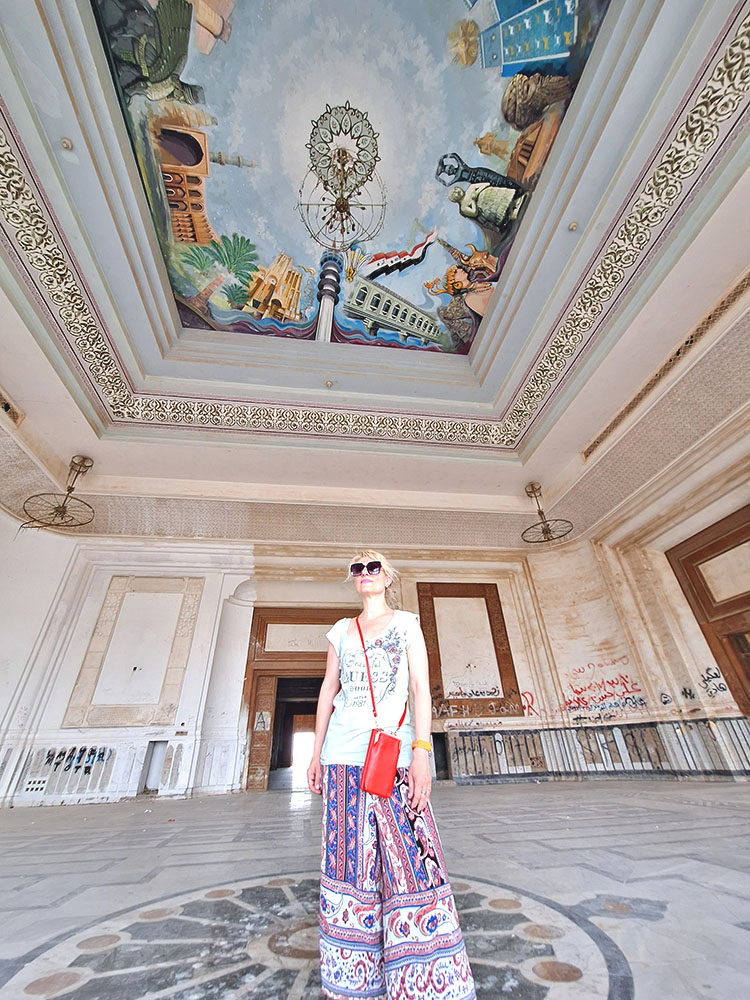
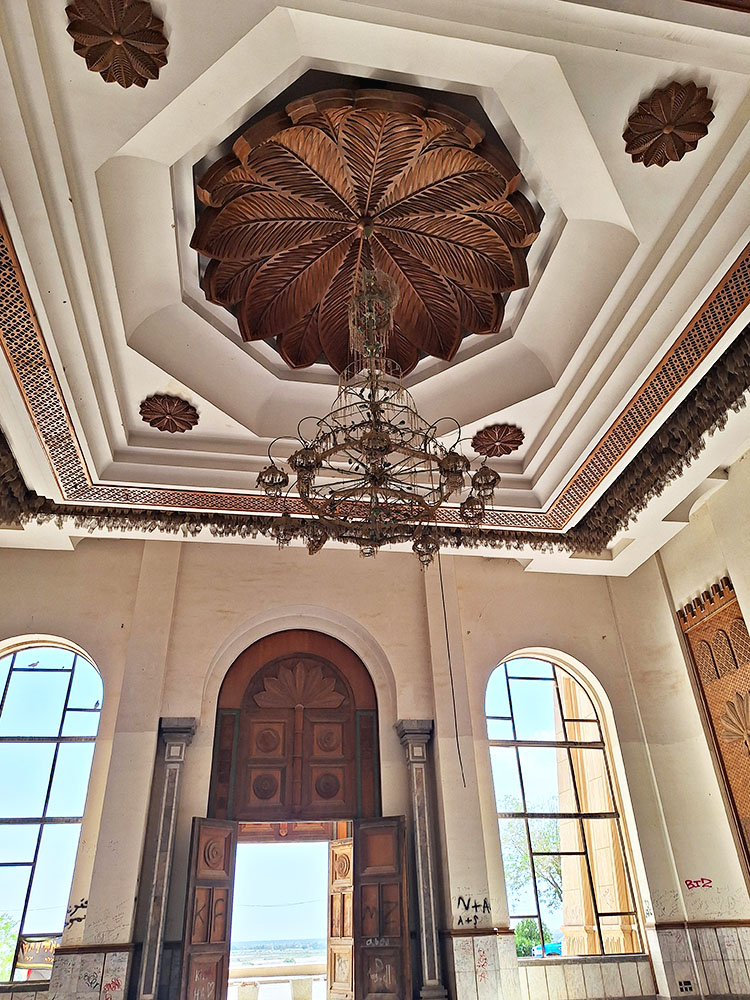
Points of interest in Babylon:
- The archaeological site and the lion statue of Babylon
- The ancient theater
- Saddam Hussein’s palace
* Entrance fee to the archaeological site: 25,000 IQD
* I was hosted by locals for 1 night close to Babylon, and moved around by private car
NAJAF & KARBALA & THE WORLD’s LARGEST CEMETERY
Najaf is the second holiest city in Iraq after Karbala, and one of the most important Shia Muslim Holy cities in the world. It is known as the burial place of Ali, and the main attraction is the huge Imam Ali shrine, famous for the golden dome and the luxurious interior decorated with countless mirror pieces. It’s located near the center of the town and considered as an important pilgrimage for Muslims.
Men and women enter the shrine through different doors without shoes, just like in every Muslim shrine and mosque. Body control is very strict, and power-banks, selfie sticks, cameras, lipsticks or any other kind of make-up are not allowed inside, and should be placed in special lockers in the vestibule of the shrine. Photography and video recording inside the mausoleum hall is forbidden, while the female guards who inspect the area use a feather to “beat” disobedient female visitors. Except for the annoying crowds inside the temple, that “feather hunting” was pretty funny!
Najaf is also famous for Wadi al-Salam, the world’s largest cemetery that stretches across the city. Its size is unimaginable, it houses about 6,000,000 corpses and you have a sight of graves as far as the eye can see. It is impossible not to notice it, since the tombs are placed everywhere, even next to the main road. The cemetery is a 1,400-year-old necropolis still in use. And in fact, it almost doubled during Iraq’s last war with ISIS, since around 200-250 new bodies were brought in every day, mostly young people killed in battle, leaving no room for the elderly who die of natural causes.
I arrived in the city around noon, after my visit to the ancient Babylon. At first, I visited the main temple, and shortly before leaving for Karbala, I strolled through the tombs that were relatively close to the temple. Since I don’t have a drone, the locals sent me to a tall building (an open car park) where I had the best view of the entire cemetery and managed to take these photos from the top floor.
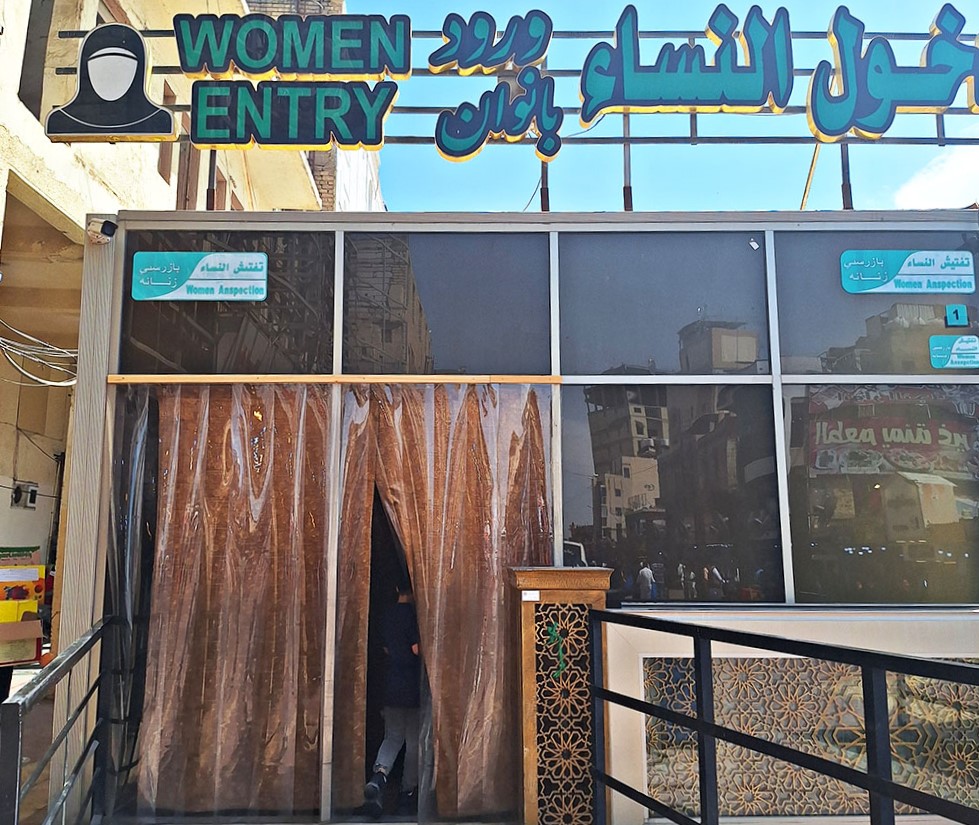
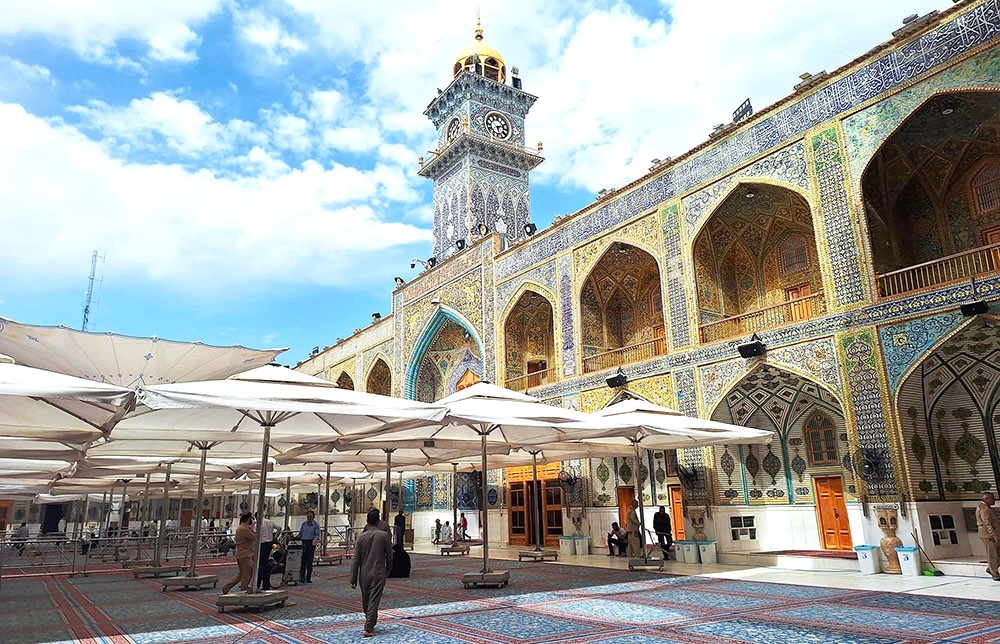
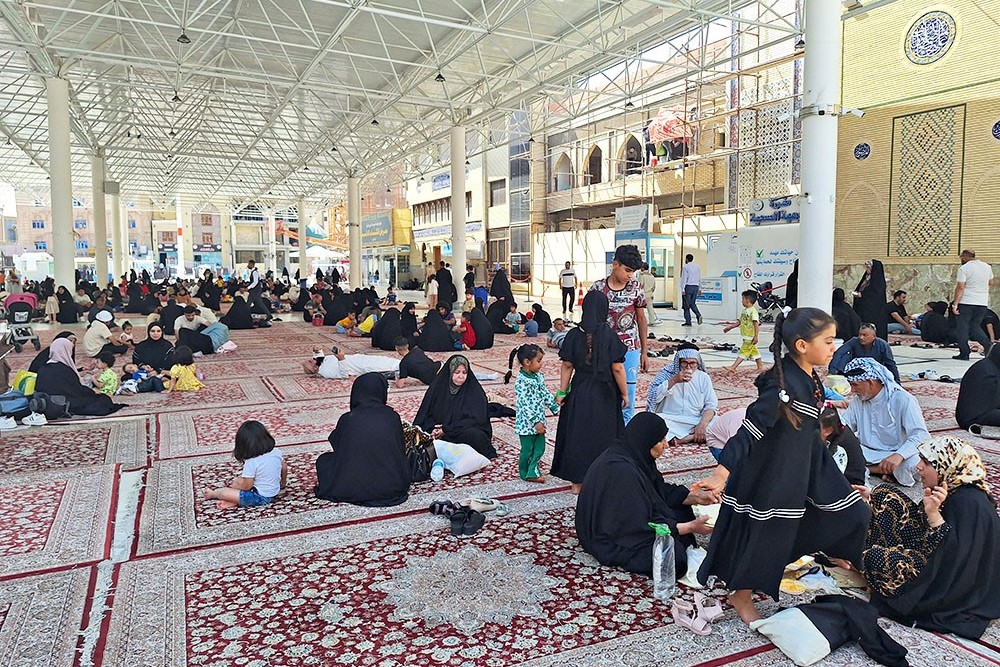
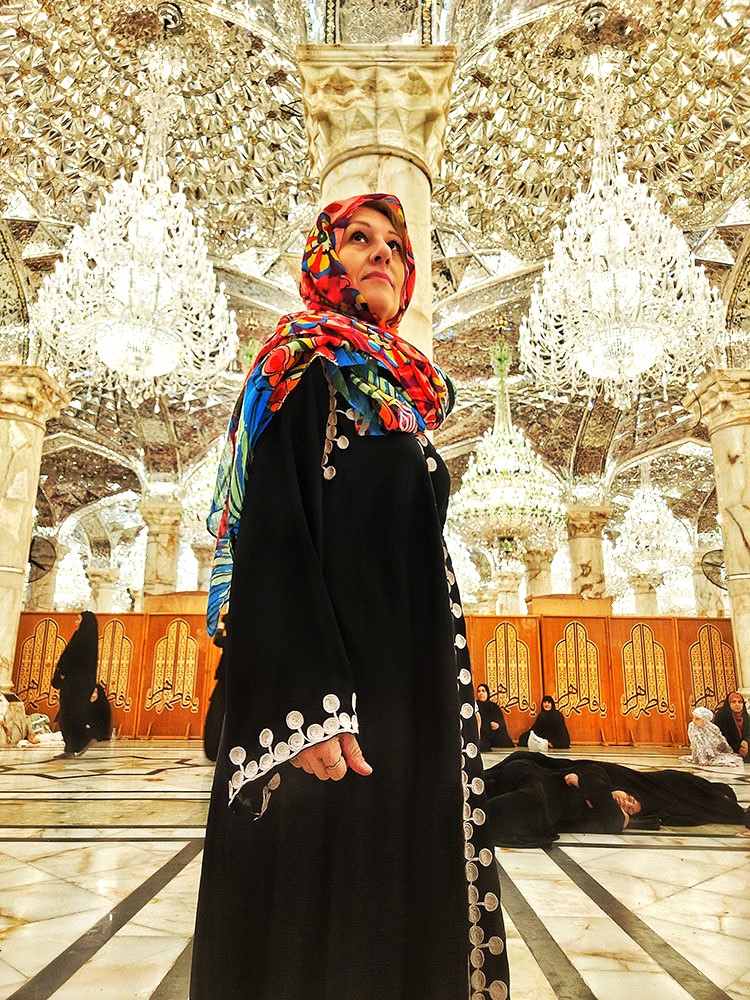
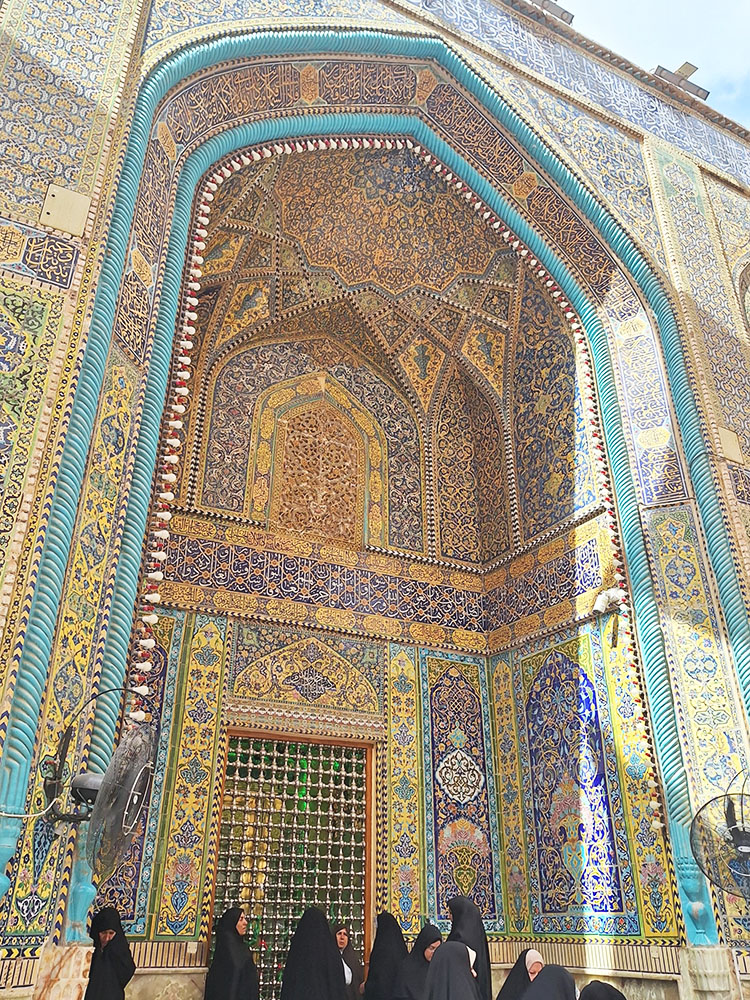
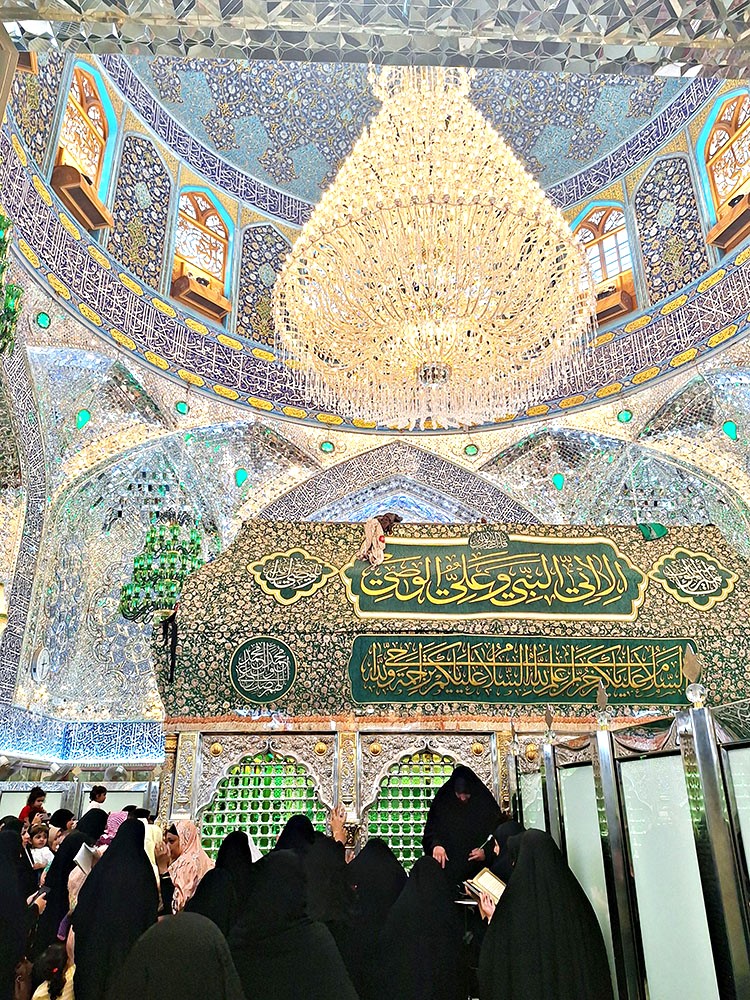
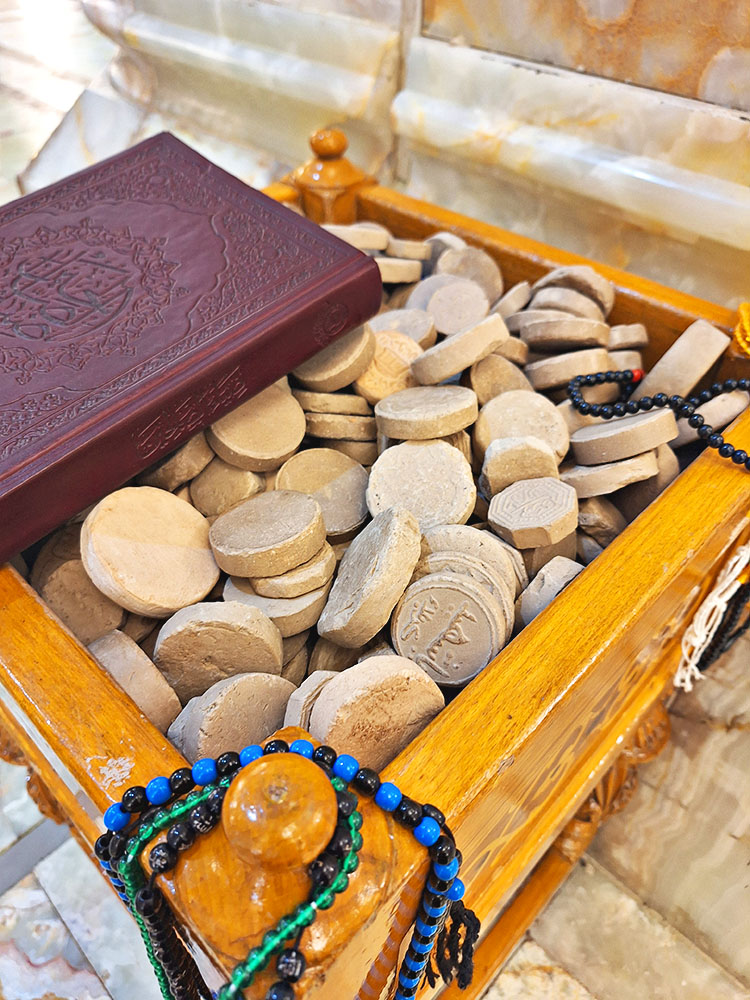
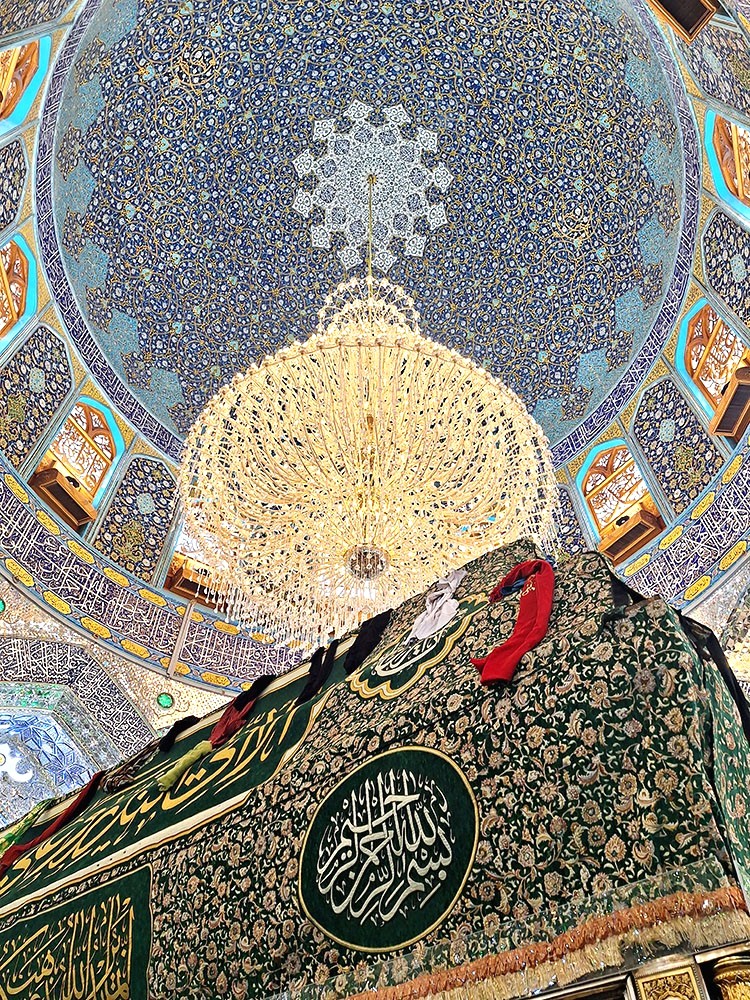
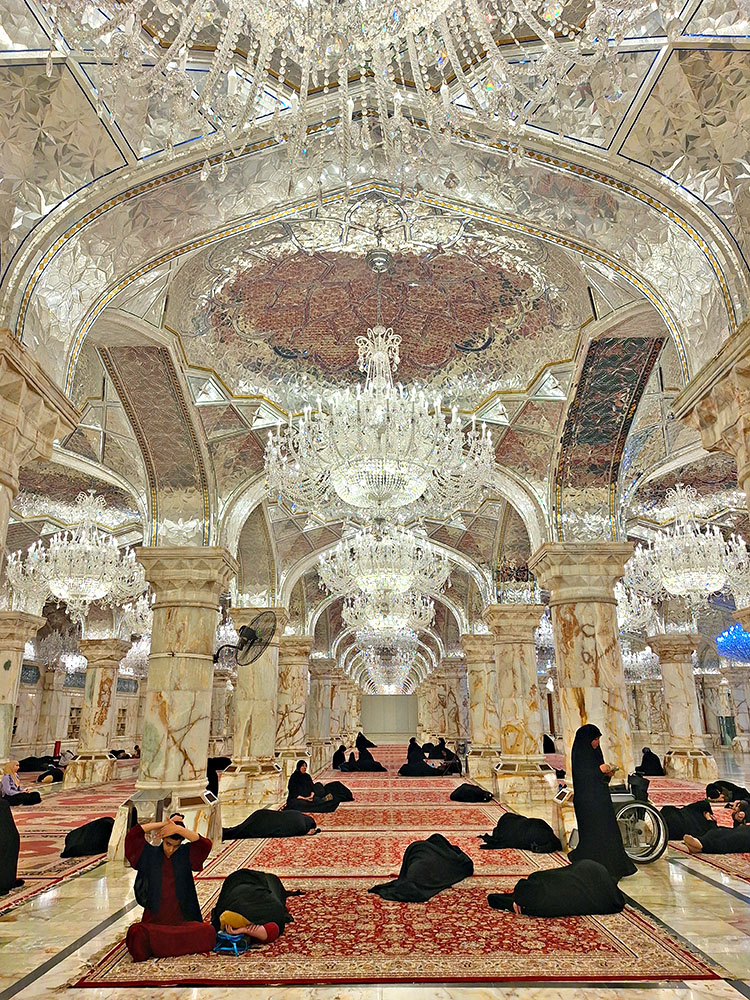
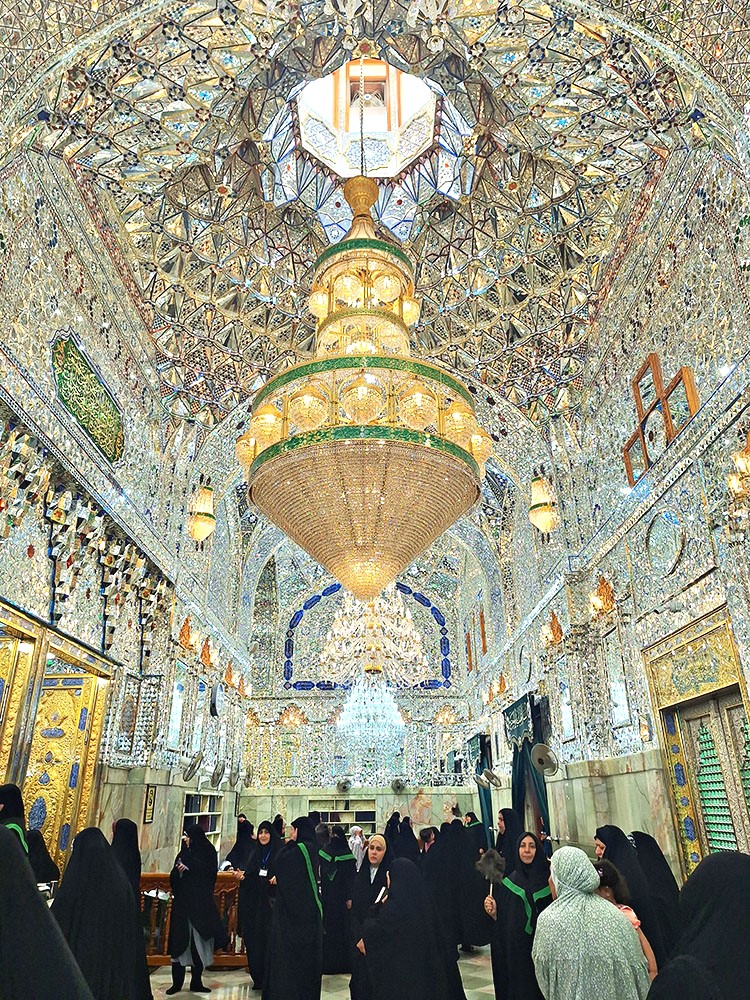
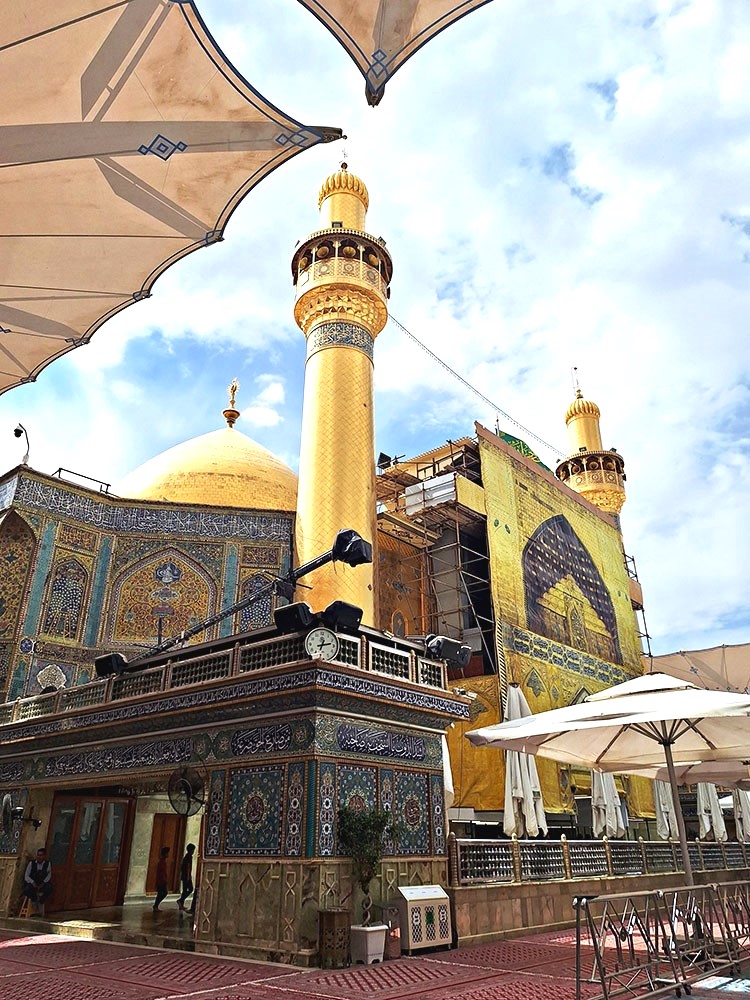
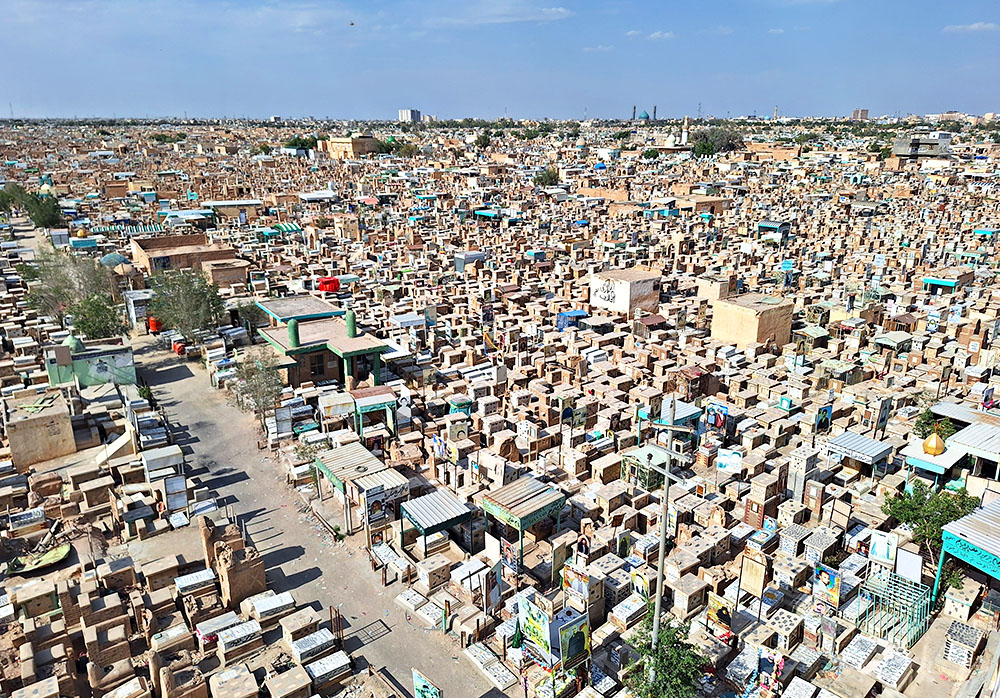
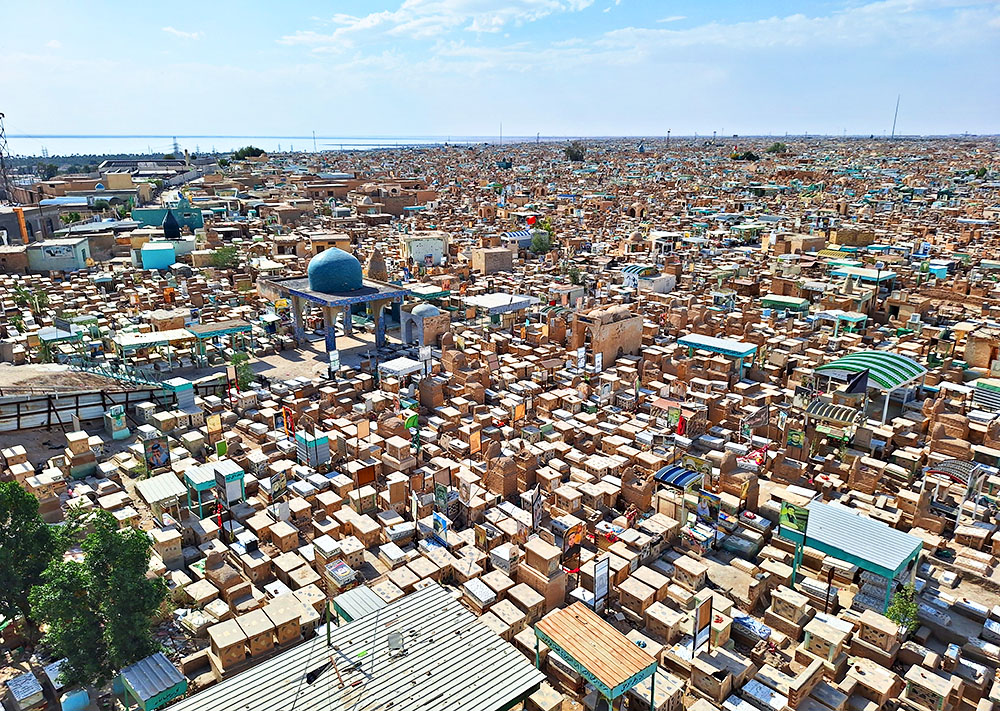
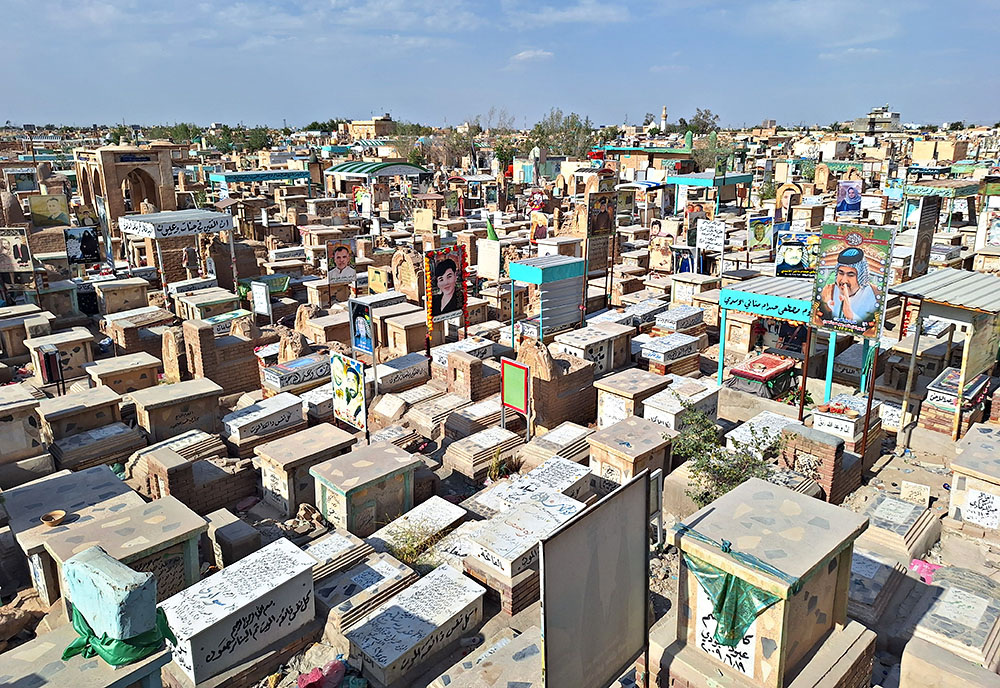
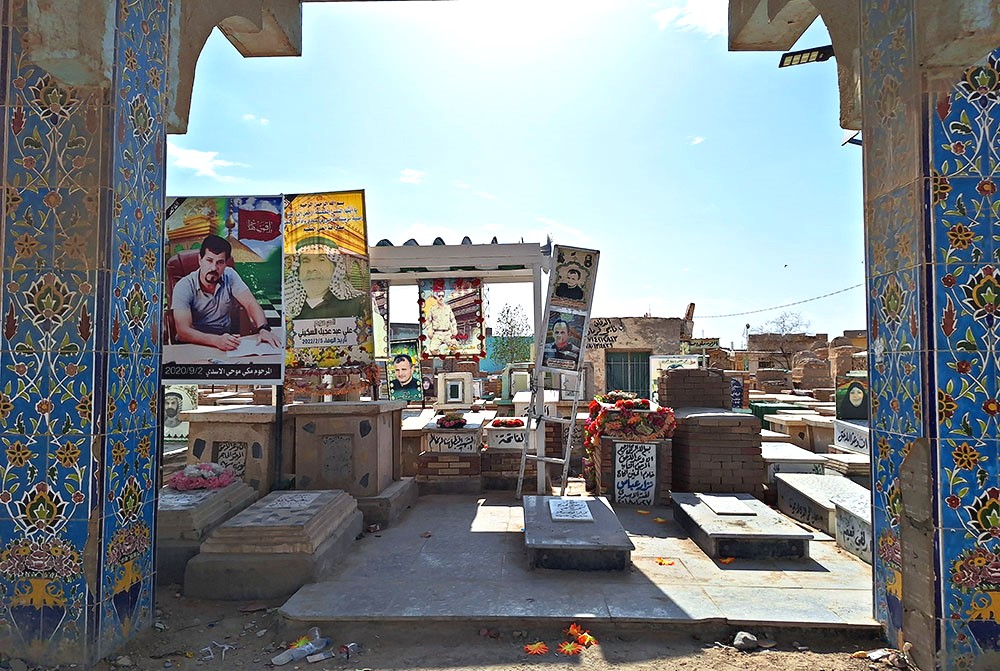
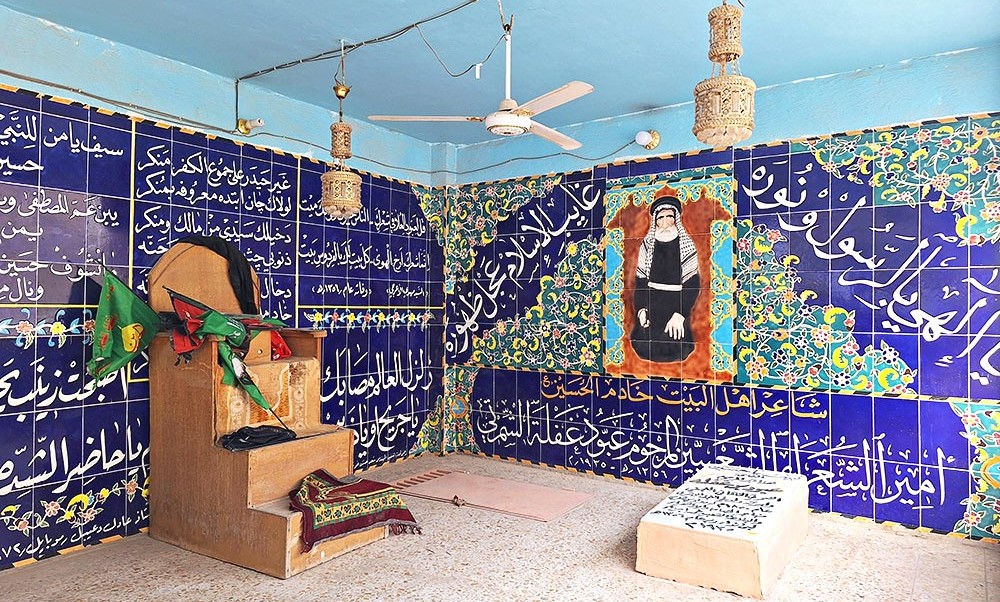
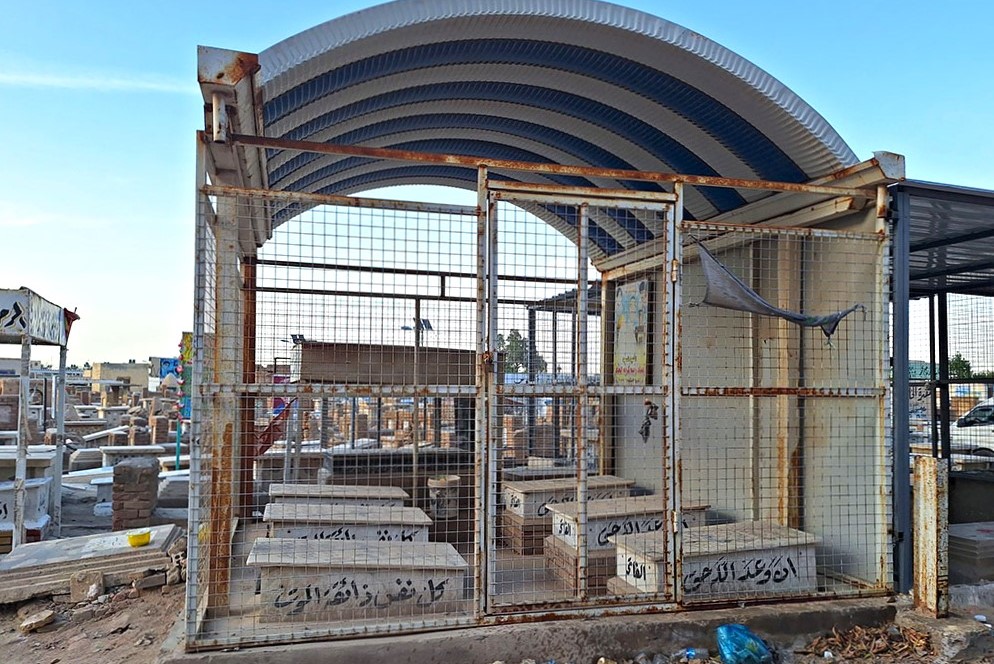
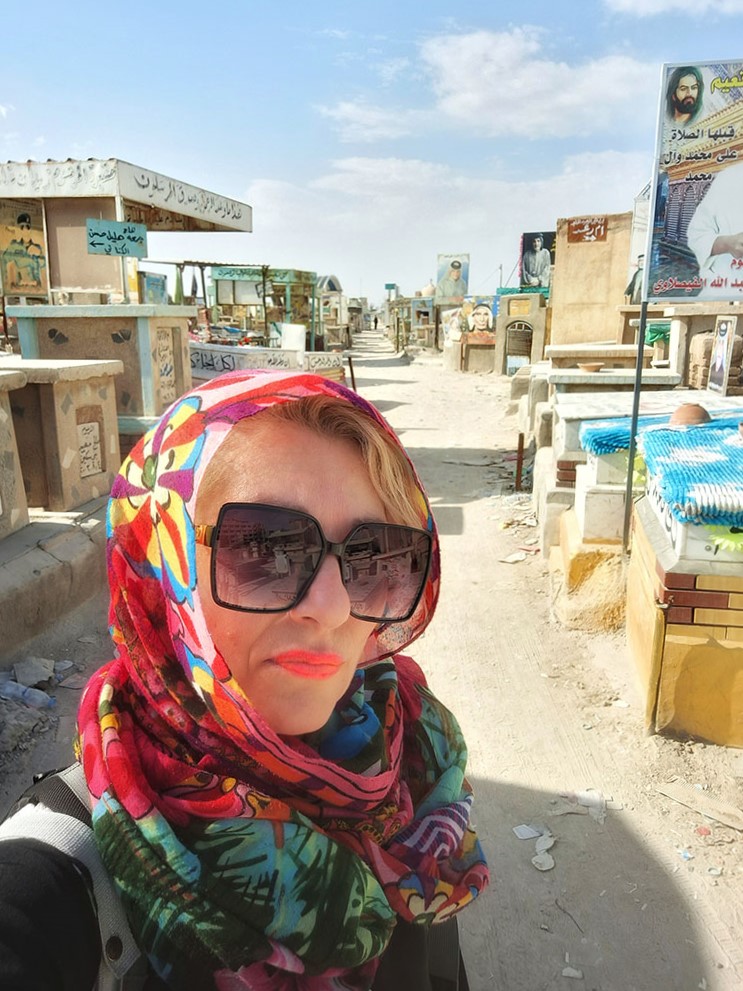
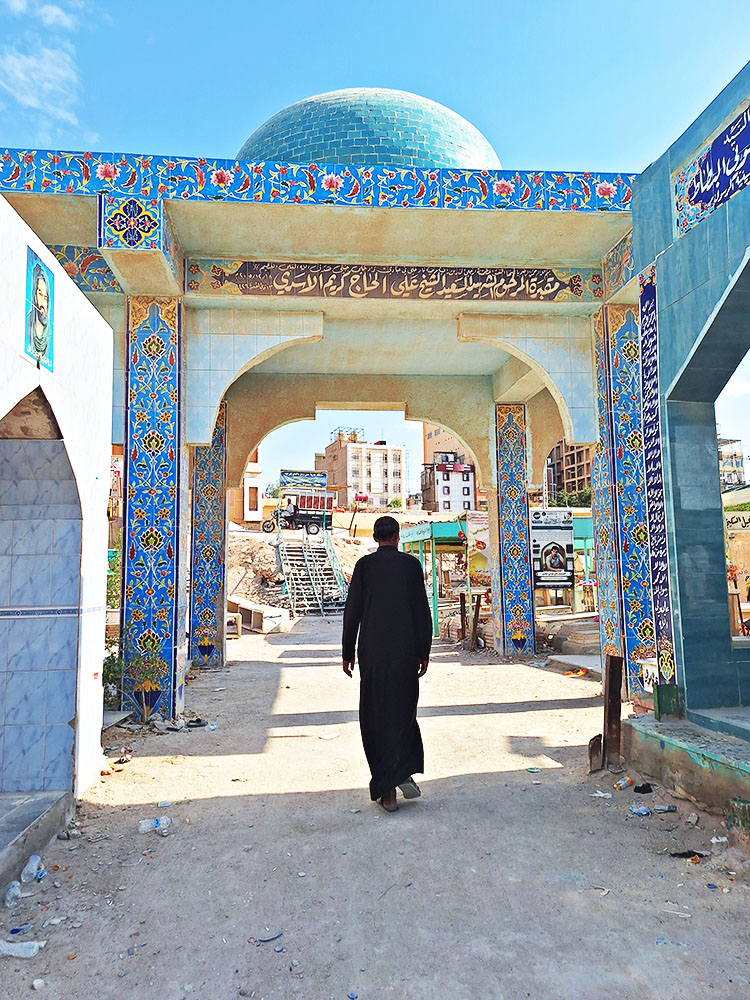
Points of interest in Najaf:
- The amazing Shiite shrine Imam Ali
- The largest cemetery in the world Wadi al-Salam
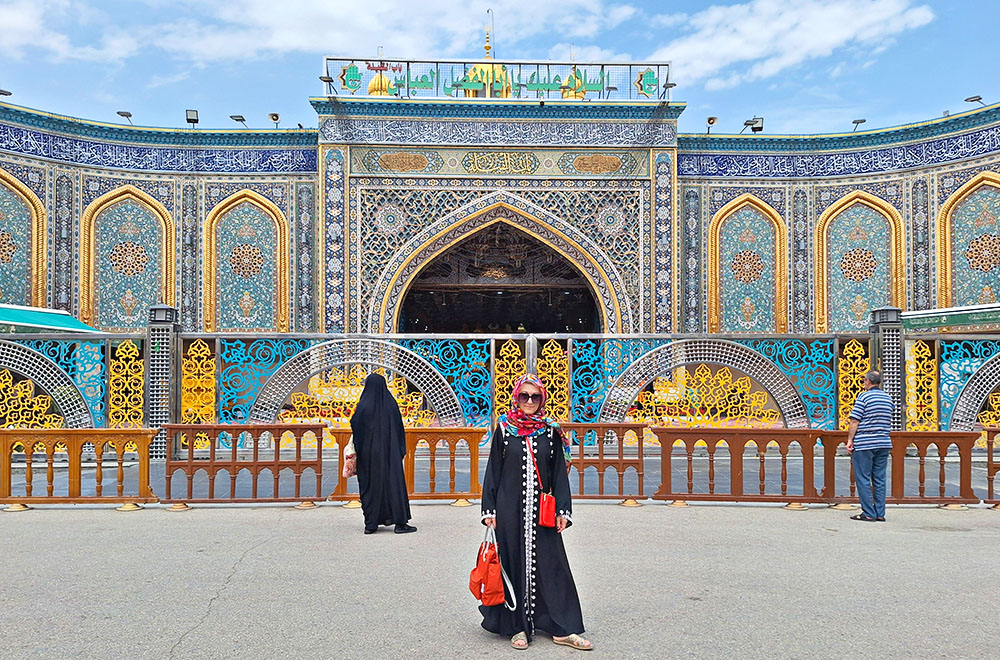
The holiest city in Iraq is also one of the holiest cities for Shiites after Mecca and Medina. Imam Hussain was martyred in Karbala and his shrine in the center of the old city is a place of pilgrimage for many Shiites, especially on the anniversary of the battle, the day of Ashura. There are two main temples and the entry regulations are exactly the same as for the Najaf temple, while the pedestrian street leading to the temples is lined with local restaurants and clothing shops. Although after sunset the entire old town is flooded with local and tourist pilgrims, there is no better time to stroll around the open-air market, while the bright lights of the temples create a very unique vibe.
Karbala left me with the best impressions, taking the place of my second favorite city after Baghdad. In addition to its very impressive center, I thoroughly enjoyed the hospitality and generosity of its friendly residents, who treated me everywhere like family!
Points of interest in Karbala:
- The neighboring Shia shrines, Imam Hossain & Abu Fadhl Abbas
- The main pedestrian street with the open-air market
- The vast bazaars behind the shrines
* I was hosted for 1 night in the new city of Karbala in a local hotel, and moved around the city by taxis, using the app Baly
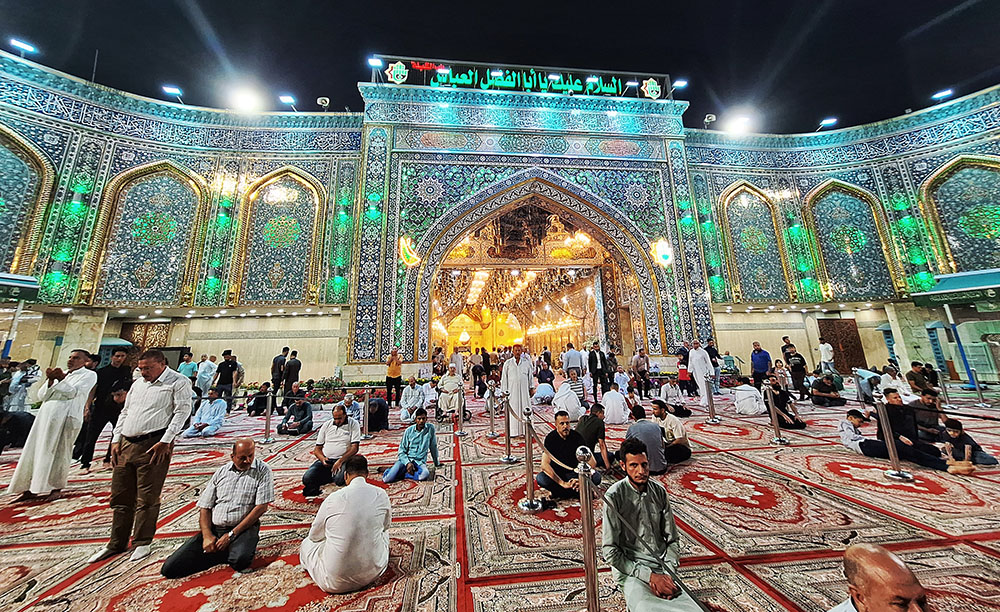
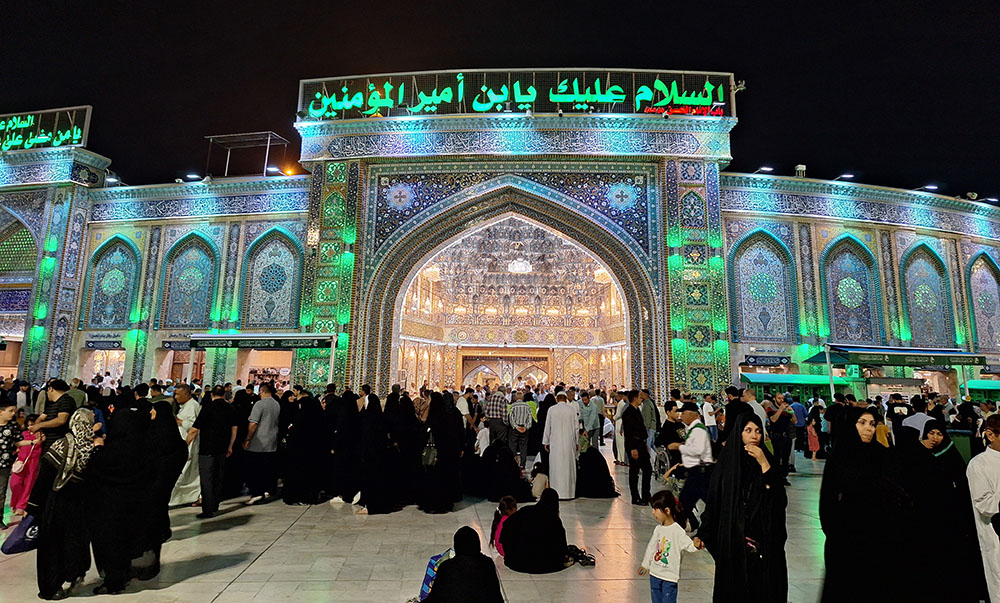
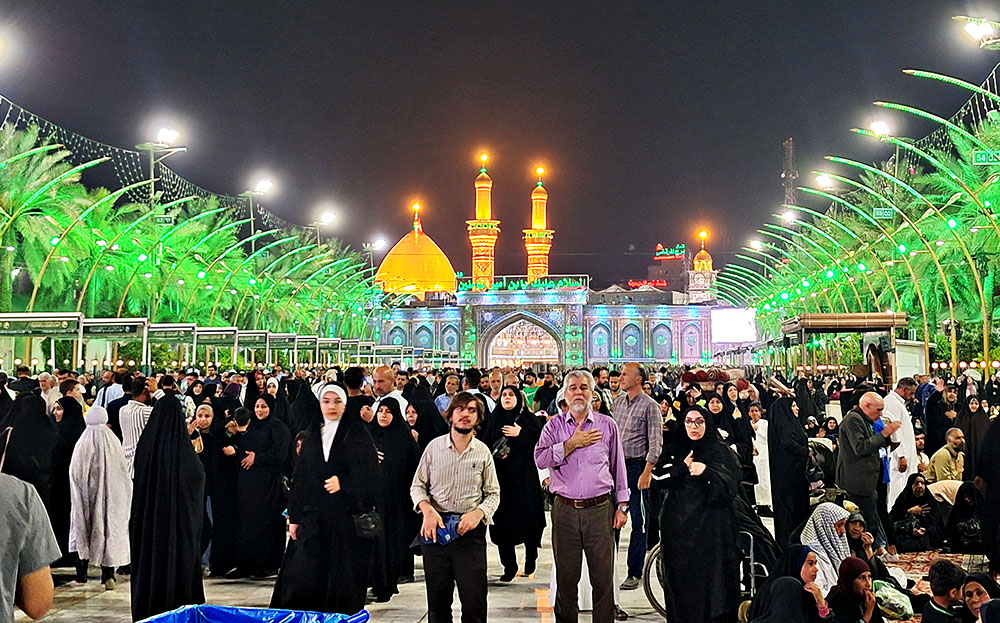
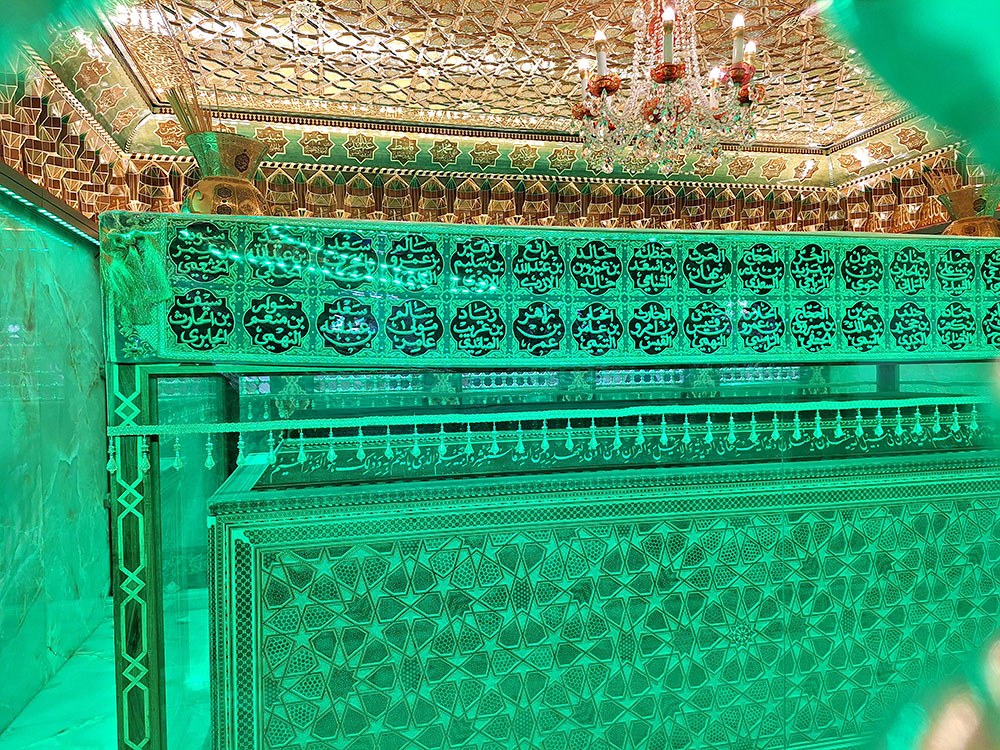
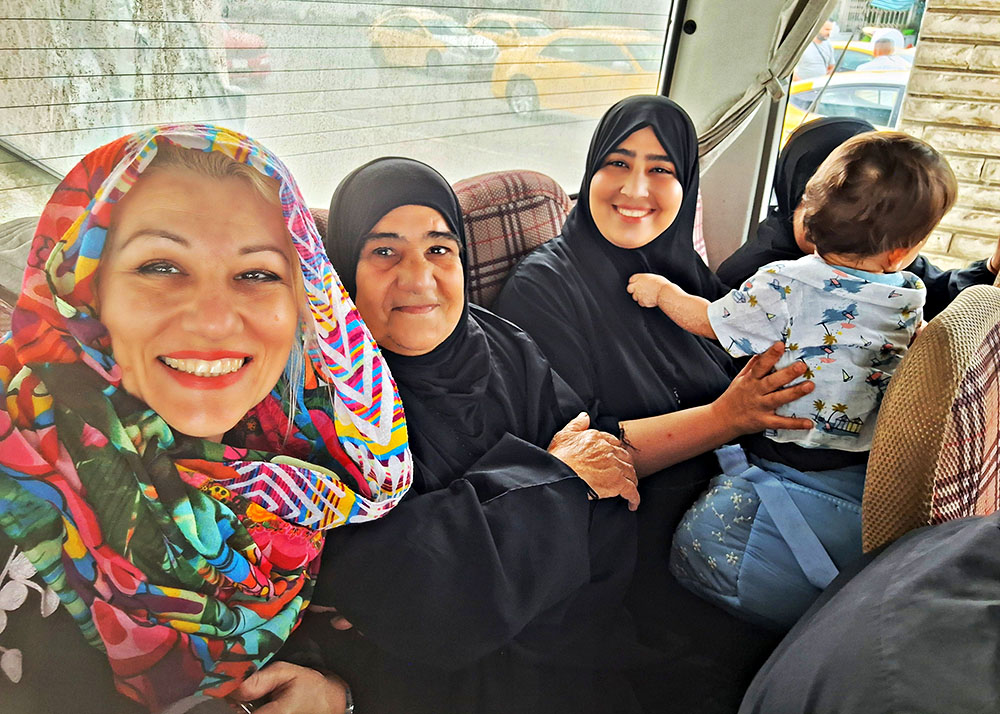
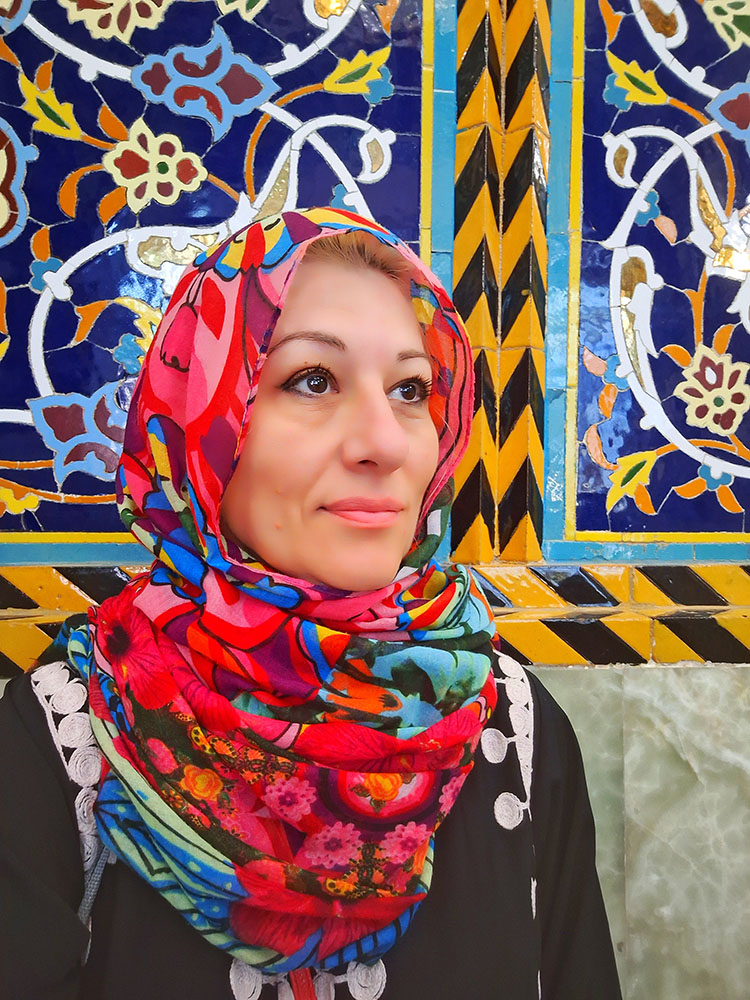
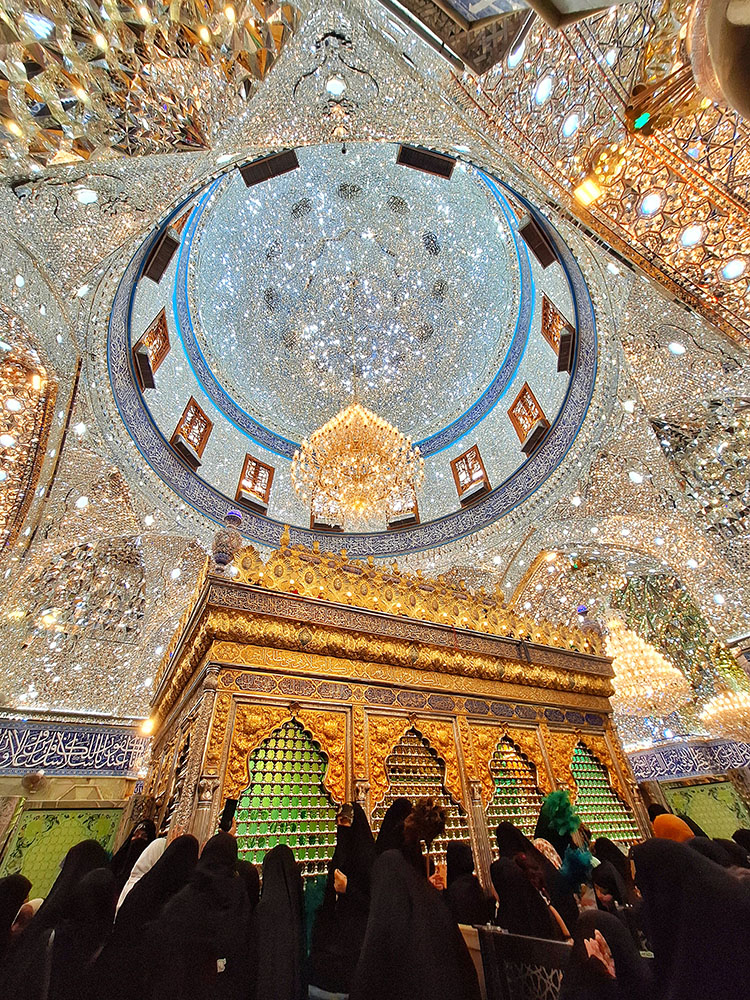
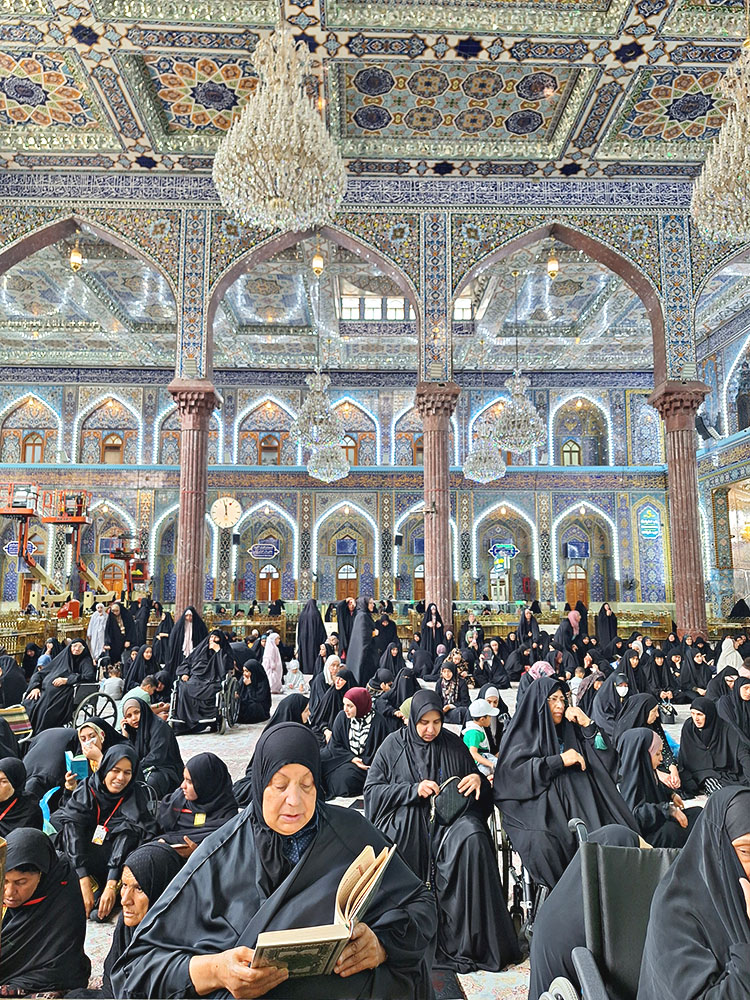
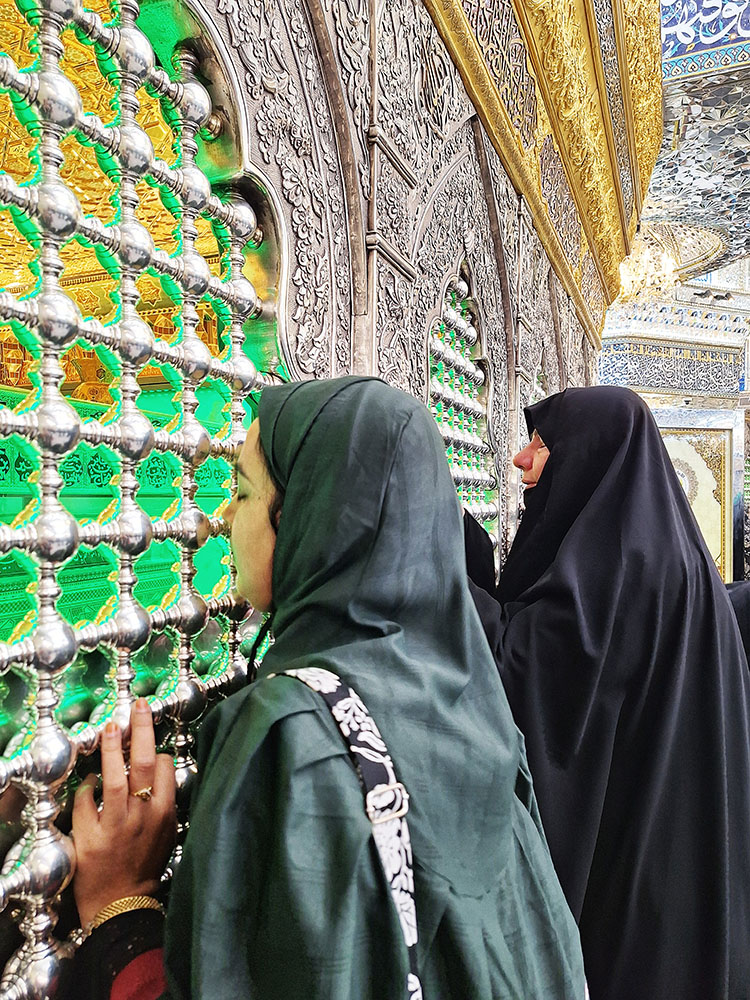
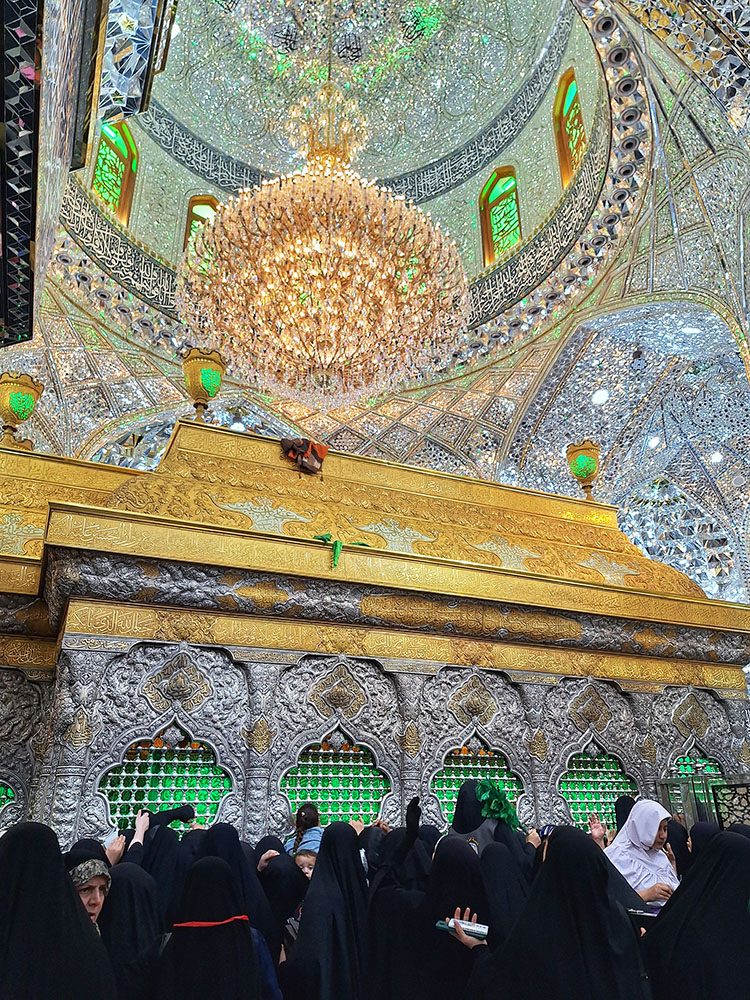
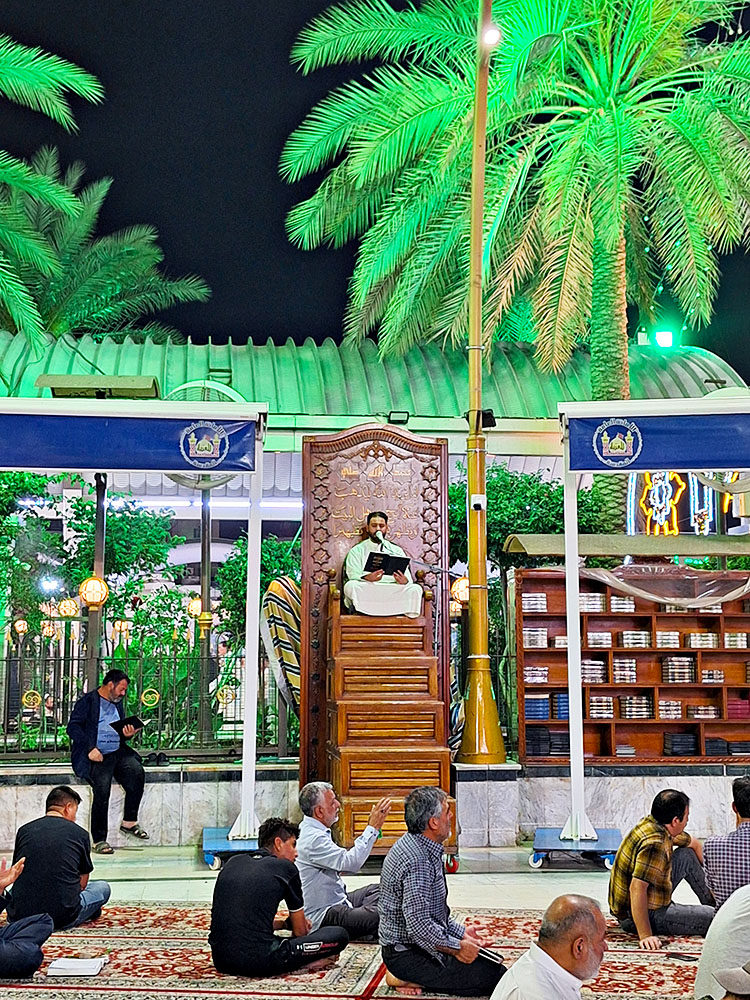
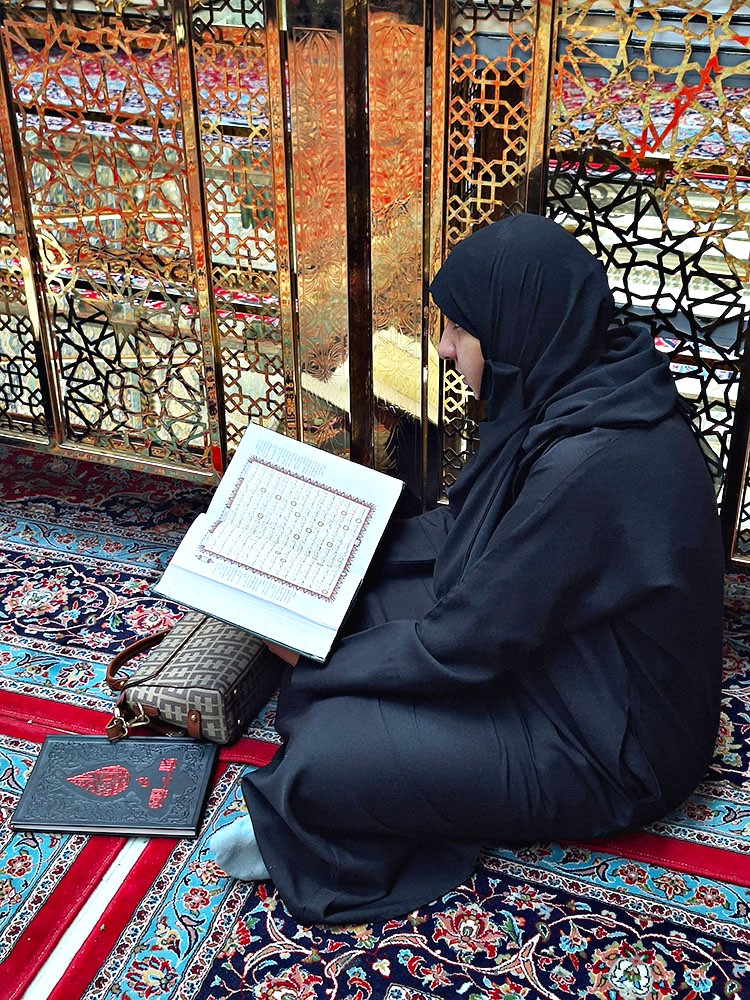
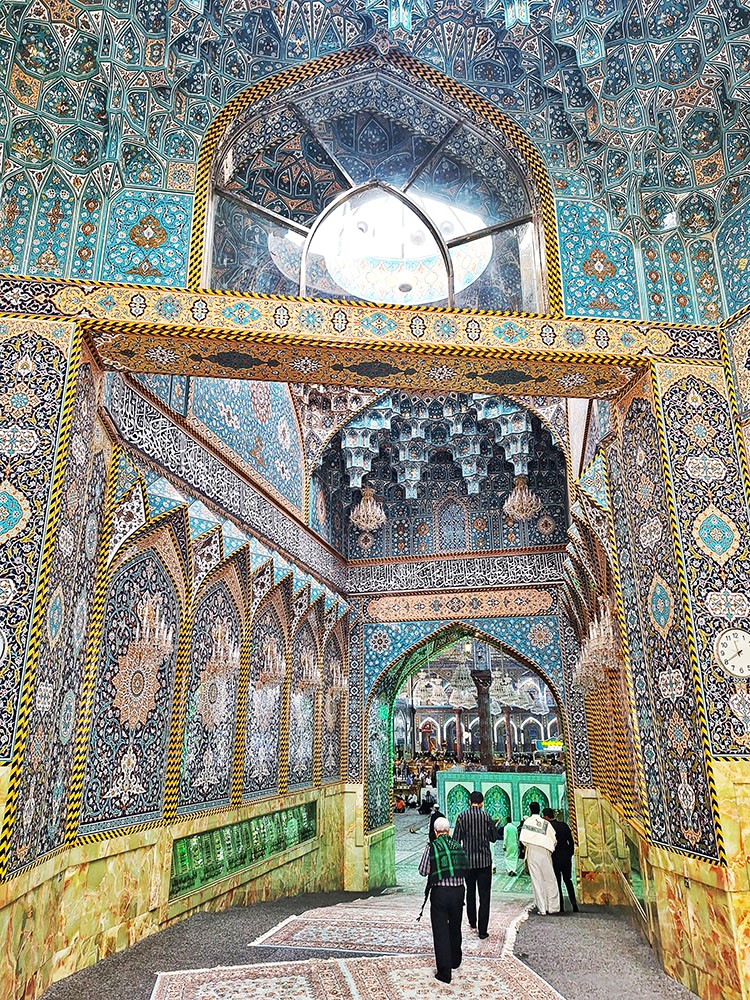
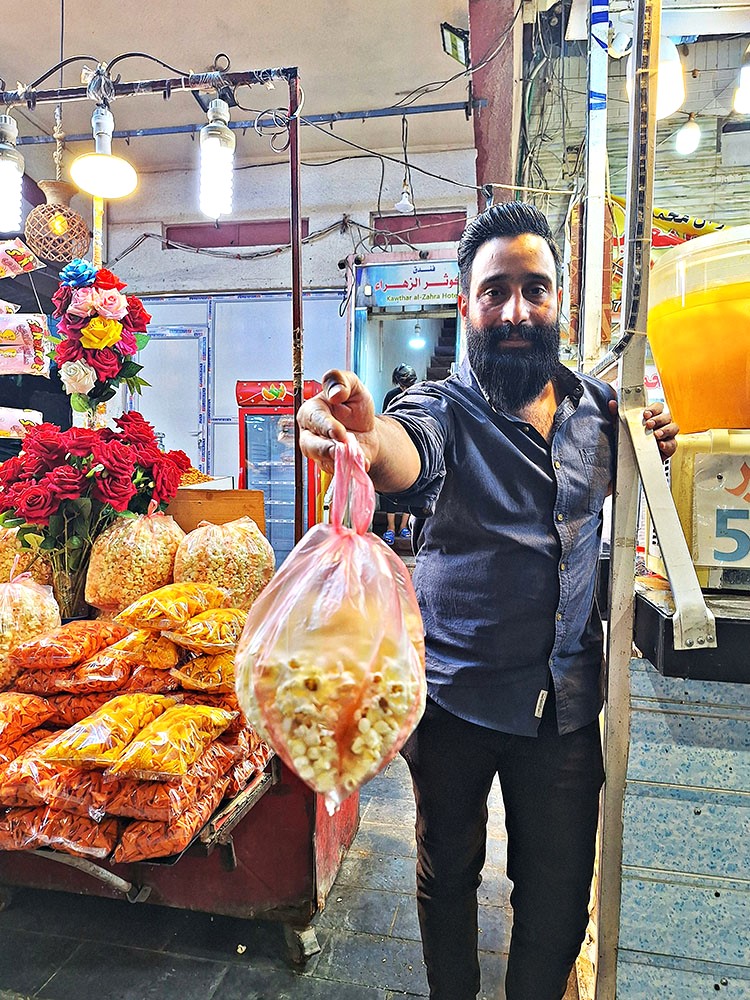
BAGHDAD
I am a huge fun of the Iraqi capital, so I can’t be objective! I stayed 3 days and 4 nights in the Kadhimiya area and visited as many monuments and bazaars as I could in the old city center. I enjoyed the delicious Iraqi cuisine in small, local restaurants and the amazing Arabic coffee in the old cafes with the unique traditional decoration and the warm people of Baghdad. (a separate post is coming soon)
Points of interest in Baghdad:
In the old town:
- Mutanabbi Street with its traditional Shabandar cafe and street markets
- Rashid Street with its small traditional cafes, bazaars and antique shops at Mudallal Market
- The copper market
- The Mustansiriyah madrassa, the world’s first university
- The Abbasid Palace
- Sunset at the Bridge of the Martyrs with views to the Tigris River
- Ferry tour on the river
In the rest of the city:
- The holy city of Kadhimiya, the Shiite Shrine Imam and the neighborhood of Al Anbareen with its colorful murals at the suburbs of Baghdad
- The Martyrs’ Monument, which was closed for construction
- The Monument “Saving Iraqi Culture”
- The Arch of Victory, inside the Green Military District Zone, which is allowed to cross by vehicle only and not as a pedestrian
- The Iraqi National Museum
- The central Tahrir Square
- The trendy Karada district
* Entrance fee to Museums, Madrassa, Palace: 25,000 IQD each
* Hotel Nooral – Ghader in Kadhimiya area: Double room for one person without breakfast: 20,000 IQD
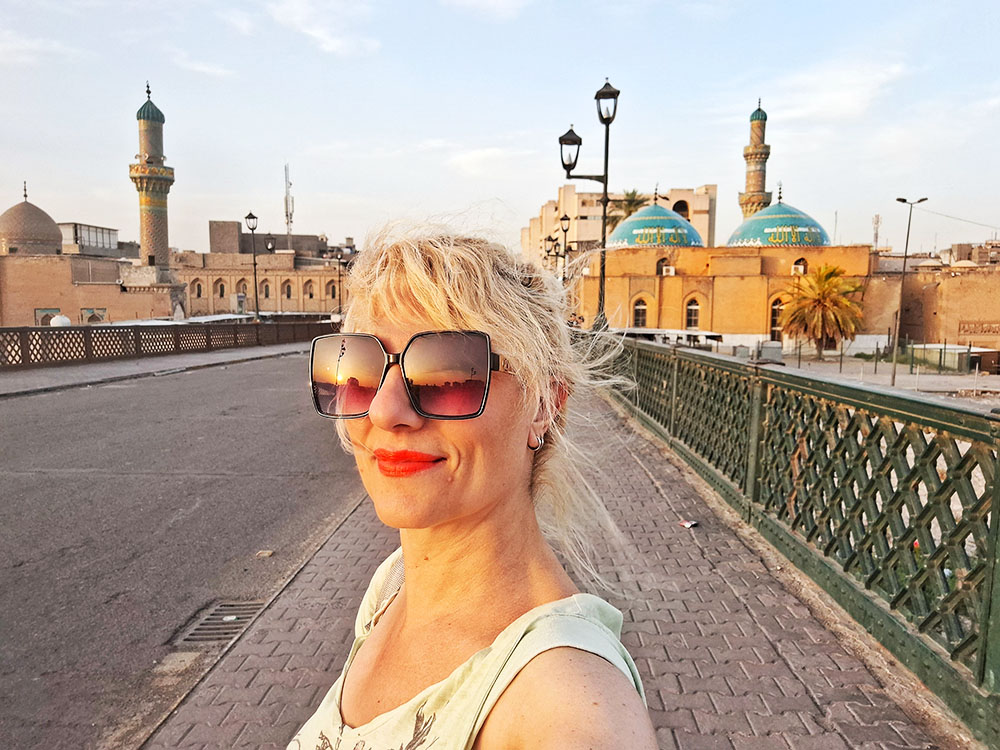
Martyrs’ bridge
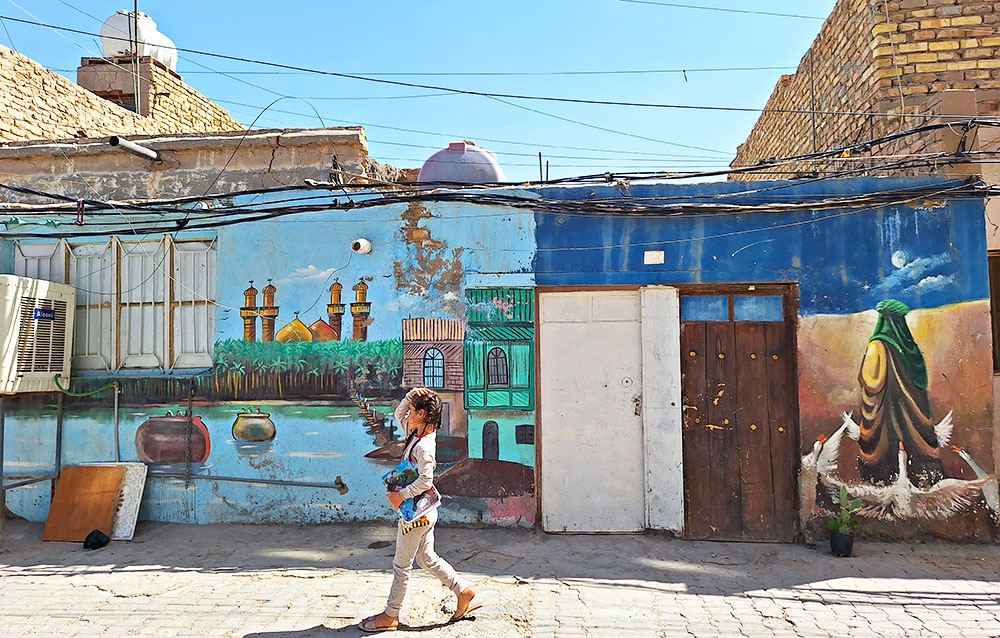
Al Kadhimiya colorful murals
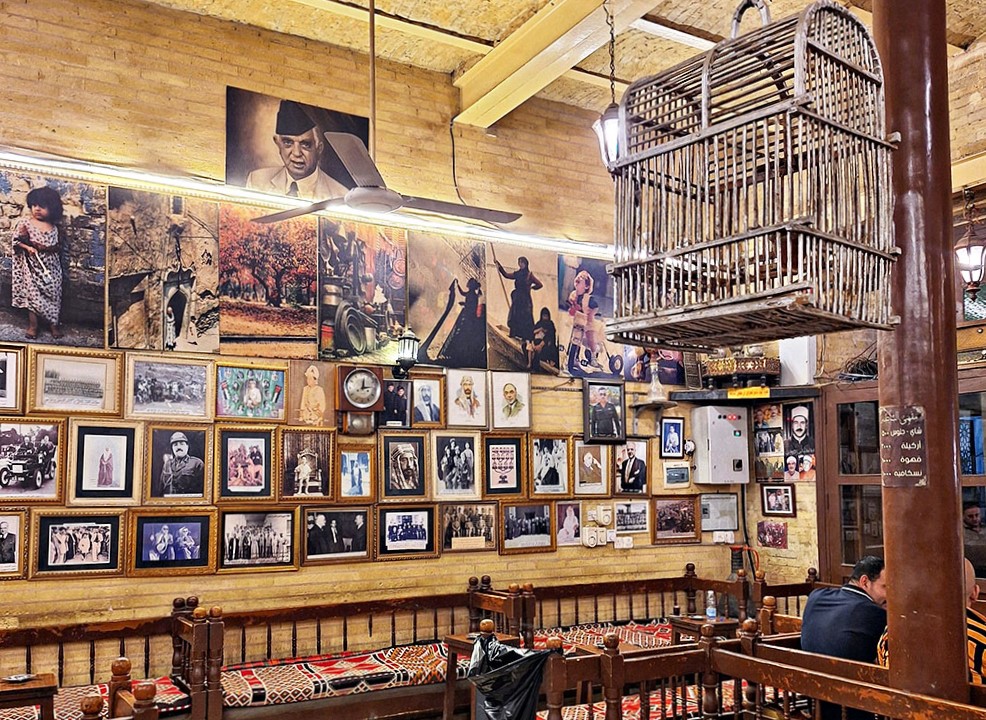
The traditional tea-house Shabandar cafe
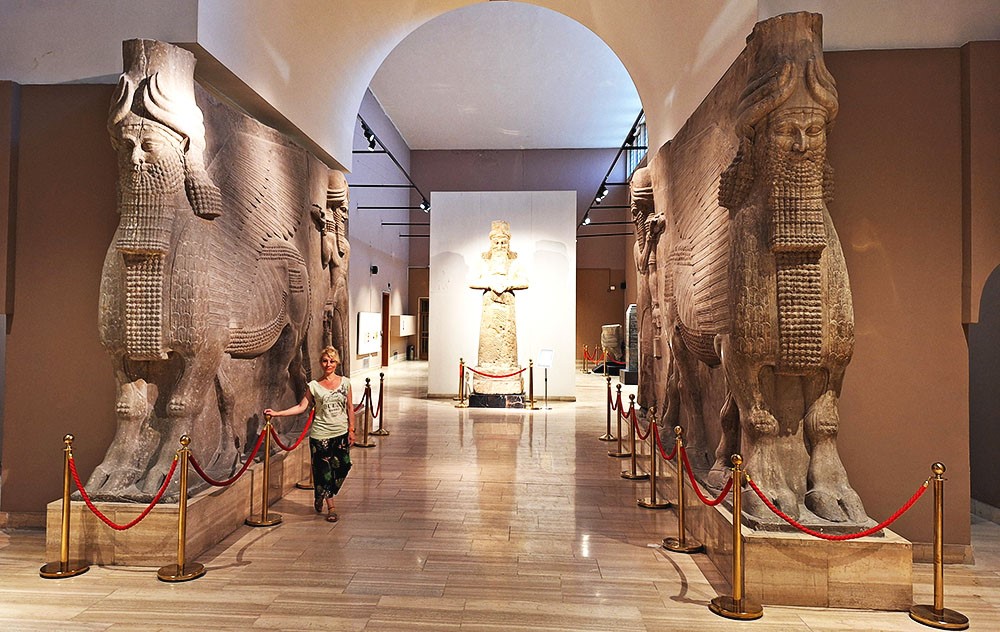
Iraq national Museum
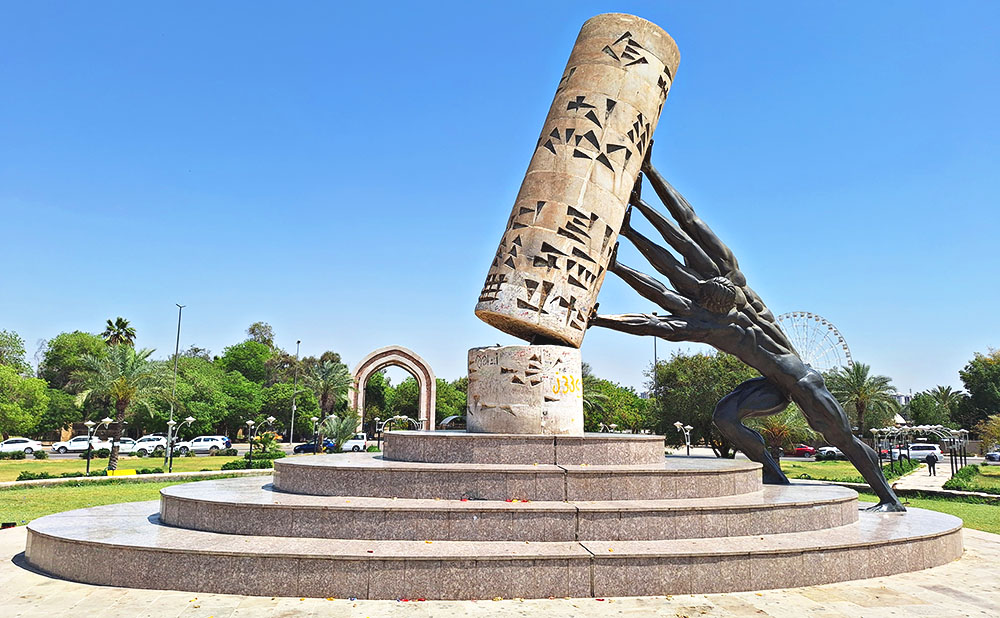
Saving Iraqi Culture Monument
SAMARRA, ABU DULAF & TIKRIT
The Great Mosque of Samarra was the largest mosque in the world at the time of its construction. It is famous for its 52-meter high spiral minaret, which was originally connected to the mosque by a bridge. During my visit in April 2024, the entire area was closed for constructions. Thankfully, the security guard was a very kind man, and not only did he let me in for a while, but he also helped me to take photos. Unfortunately, he did not allow me to get closer to the minaret, for security reasons.
Samarra ‘s alternative mosque & minaret located in an open space in the middle of the desert is the impressive Abu Dulaf Mosque, just 20 km north of the city. The spiral minaret reaches 32 meters, and the view from the top to the arid and desert landscape that surrounds it is very impressive.
I then ended up in the town of Tikrit in order to spend the night at a random hotel, since it was already late and I couldn’t find any public transport to go straight to Mosul. Tikrit, the birthplace of the founder of the Ayyubid dynasty Saladin and Saddam Hussein, was the second most important city in the country destroyed by ISIS after Mosul. The city is said to have the largest number of luxury palaces built under Saddam, and the remains of the Presidential Palace still stand on the banks of the Tigris River.
Points of interest in the area:
- The great mosque of Samarra and the imposing spiral minaret of 52m.
- Imam Ali Shiite shrine in the city center (I didn’t visit due to lack of time)
- Abu Dulaf spiral minaret, 20km outside the city of Samarra
- The city of Tikrit and the Presidential Palaces
* To enter the town of Samarra, the visitors must leave their passports at the first checkpoint and collect them again on the way back
* Private taxi ride from Samarra to Abu Dulaf: 15.000 IQD both ways
* Abu Dulaf minaret is free of charge
* Tikrit hotel Plaza: Double room for one person with breakfast: 25,000 IQD
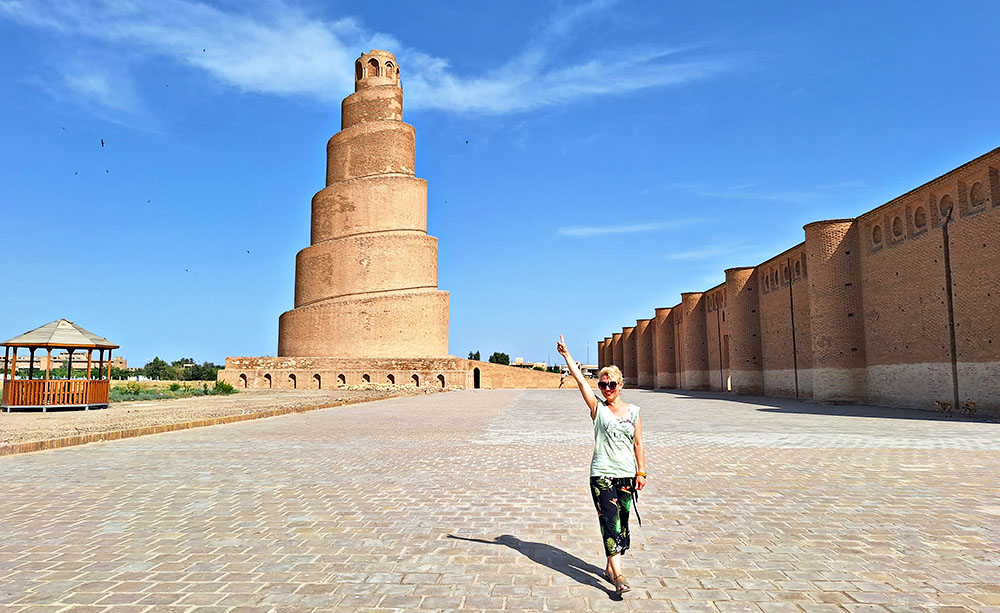
The Great Mosque and the spiral Minaret of Samarra
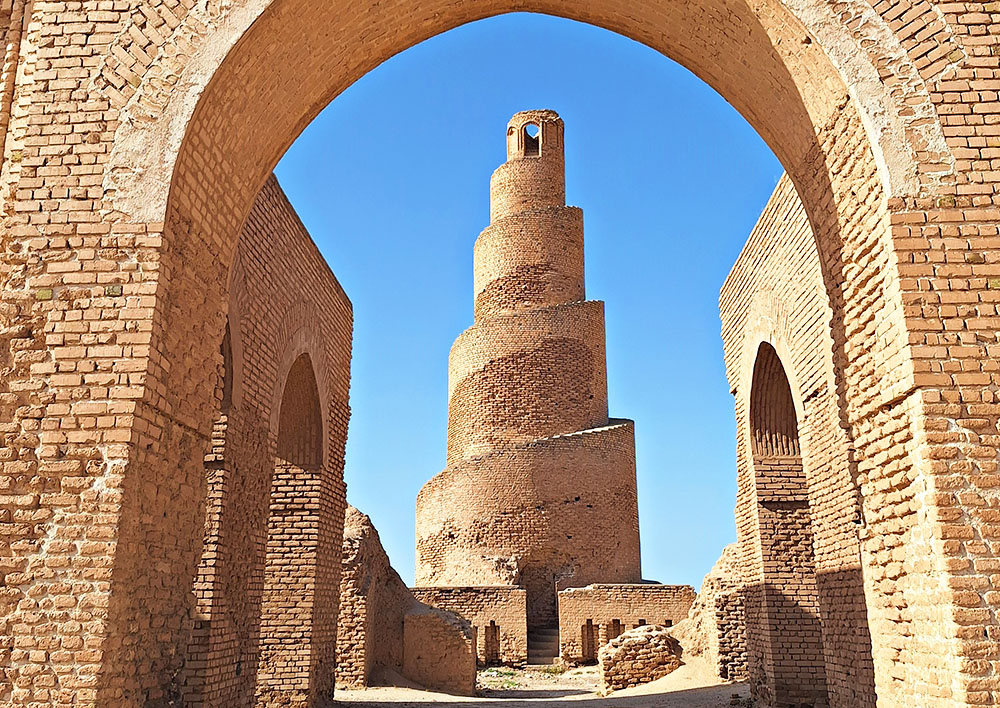
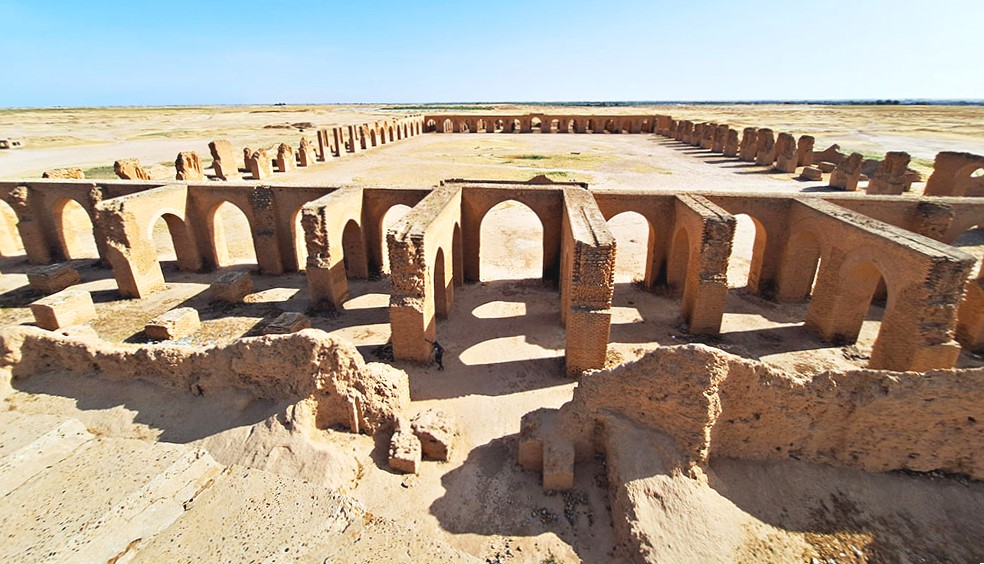
Abu Dulaf mosque from the top of the minaret
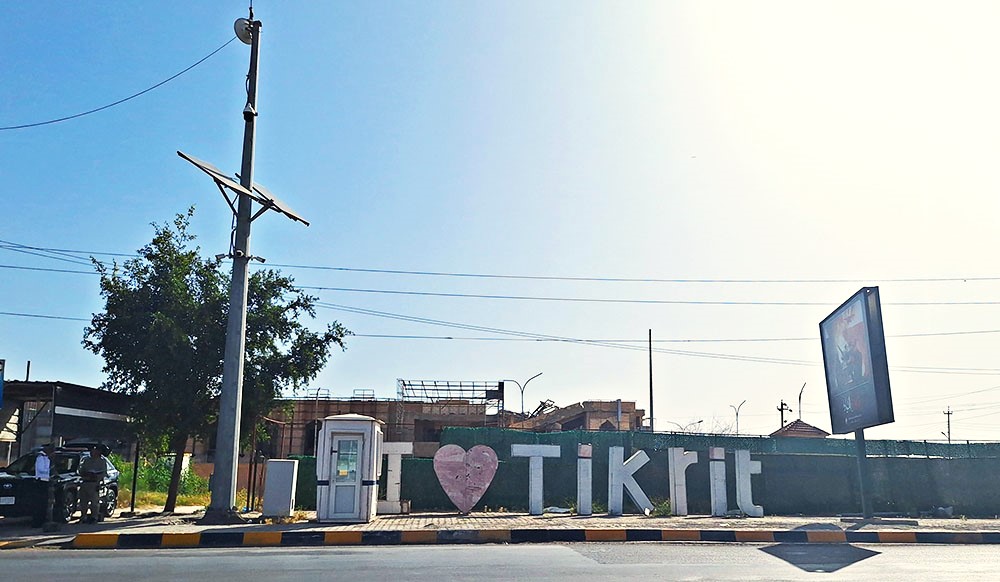
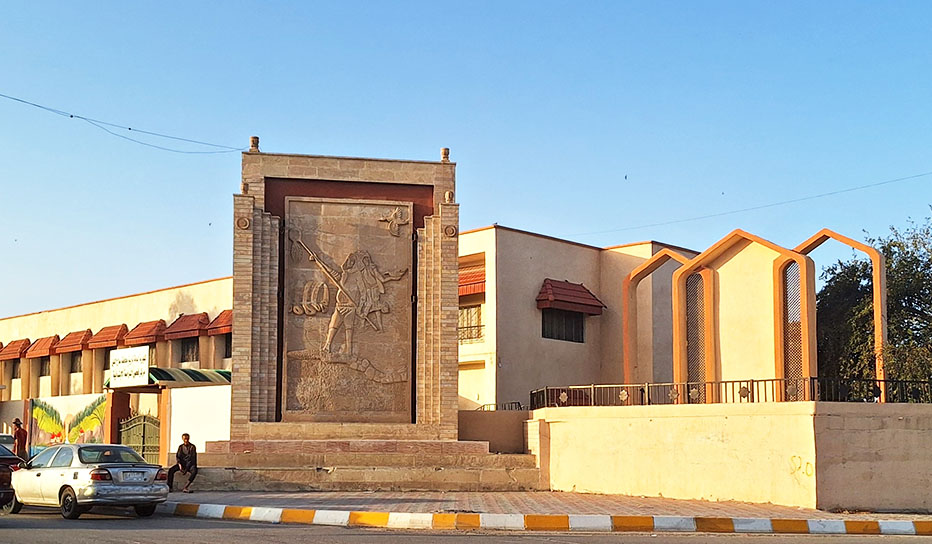
Tikrit town
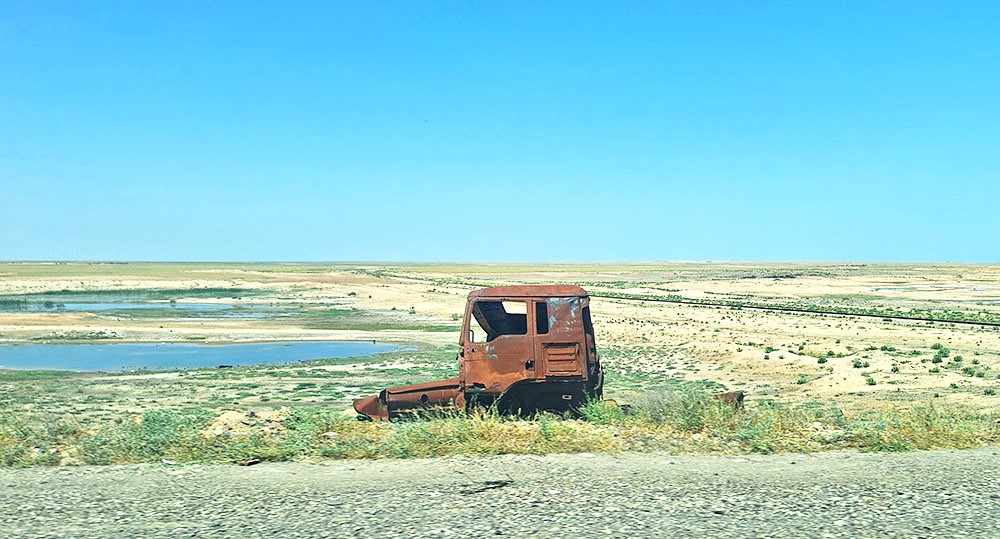
On the way from Tikrit to Mosul
MOSUL
The city of Mosul, meaning “the connecting point” in Arabic, is one of the oldest cities in the world. It was a strategic location between north and south, east and west, and was captured by ISIS in 2014. During the occupation and battle for Mosul, centuries-old buildings, mosques and churches were destroyed, burned or severely damaged. Since the defeat of ISIS in 2017, some 5 million people have already returned home, according to the International Organization for Migration, although Mosul was never entirely abandoned by its residents. The old city on the “Right Bank” (west side) of the Tigris River still remains in ruins, while a part of it has been reconstructed by UNESCO and the UN.
I arrived in Mosul early in the afternoon, straight from Tikrit and together with locals and some tourist women I met by chance, we walked around Saddam’s unfinished mosque and all over the old city, exploring the ruins of the destroyed side, but also the everyday life of the locals who have already come back to the restored area. (a separate post is coming soon)
Points of interest in Mosul:
- The old, ruined city on the east bank of the Tigris river, UNESCO monument
- Saddam’s Mosque or the Great Mosque of Mosul in the West Bank, which remains unfinished to this day as work was halted due to political instability in the country
- Hatra ancient town (tickets can be purchased from Mosul only)
* Kahramana Hotel: Double room for one person without breakfast: 20,000 IQD
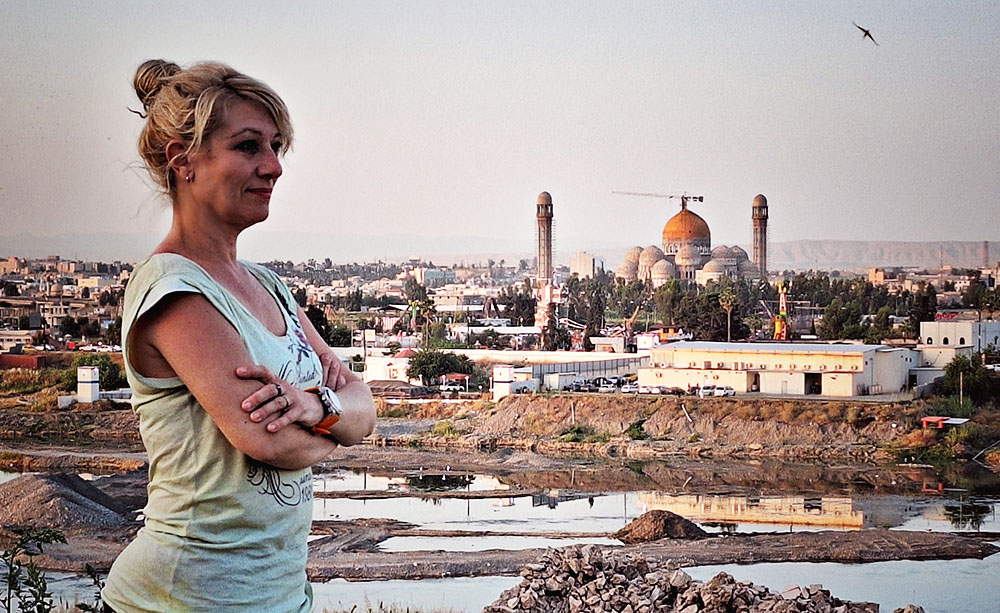
The great mosque of Mosul
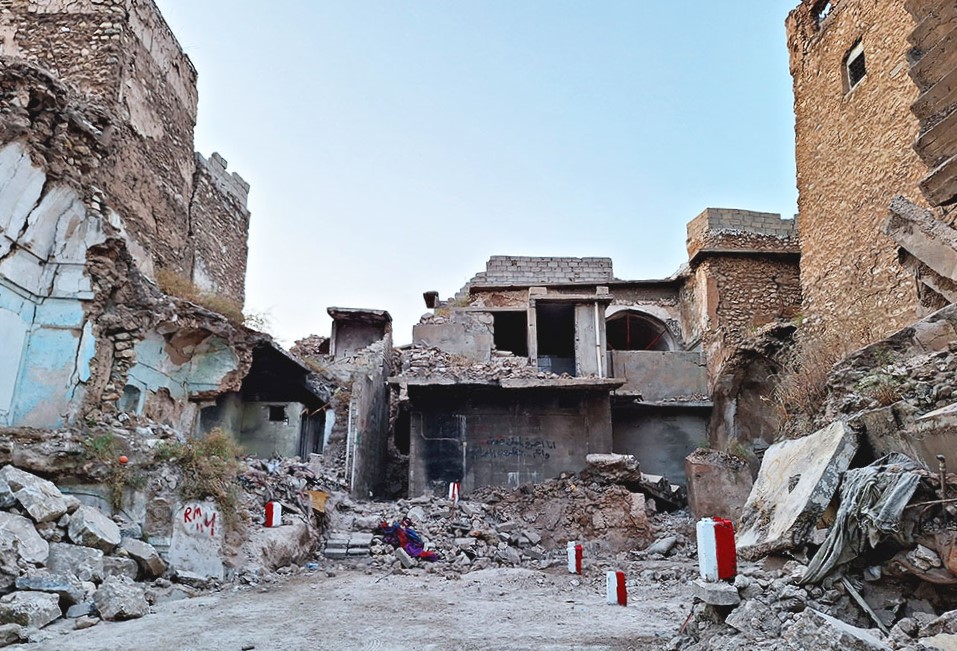
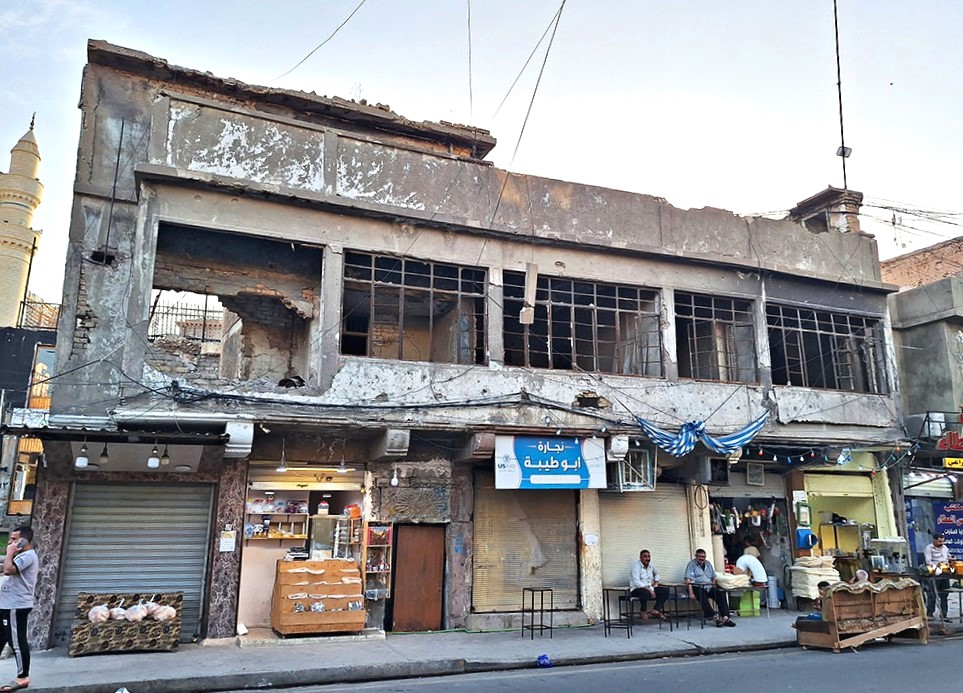
Mosul Old Town
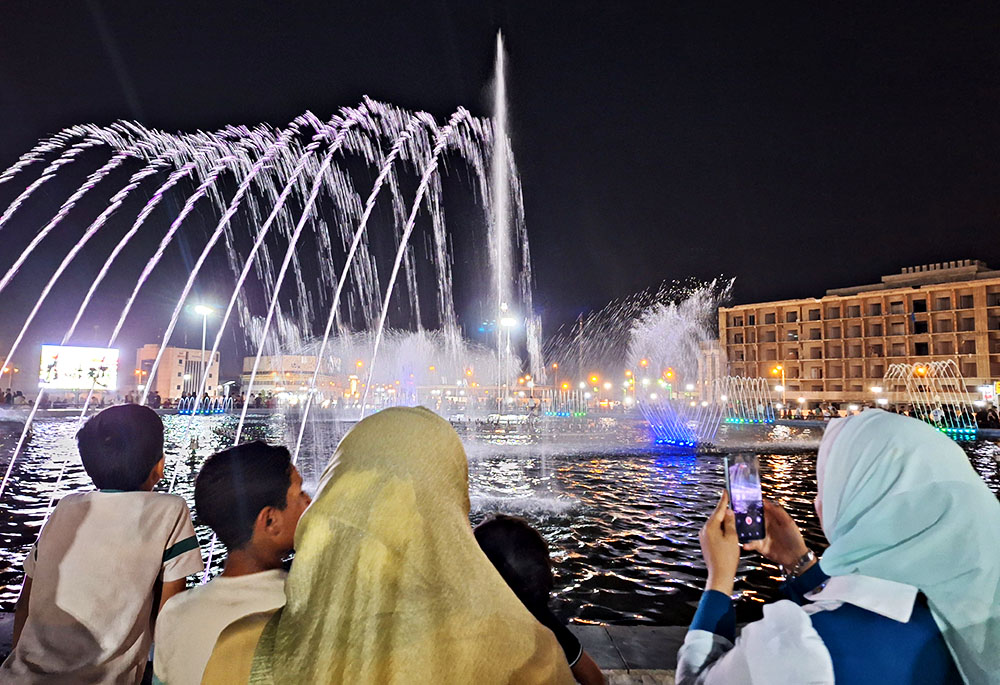
Al Remah square in the old town of Mosul
Useful information
Visa on arrival at the border of Kuwait – Iraq Safwan (VOA): price for the Greek passport $80 (€74.50). Payment in US dollars only (they do not accept any other currency)
Currency: Iraqi dinar / 1€ = 1415 IQD (exchange offices can be found everywhere on the streets)
Local SIM card: Asiacell network offers a great variety of data packages. I bought a card with 20 Gb, paying 26,500 IQD for 20 days
Entrance fee to museums, monuments, ancient sites: 25,000 IQD each
Indicative prices for food/drinks:
- Arabic coffee: 1,000-3,000 IQD
- Ayran: 1,000 IQD
- Falafel sandwich: 1,000-1,500 IQD
- Kebab: 3,500 IQD
- Breakfast omelet & juice: 5,000 IQD
- Kunafa: 2,000-3,000 IQD
- Full meal in a good restaurant: 11,000 IQD
Transportation within the cities: Baly taxi app and city buses
Indicative prices in Baghdad:
- Tahrir Square – Kadhimiya: 5,800 IQD by Baly taxi
- Kadhimiya – center/old town: 3,500 – 4,500 IQD by Baly taxi
- City bus ticket: 250 – 500 IQD / one-way
Cost of moving around the country:
- Basra – Nasiriyah: 15,000 IQD by shared taxi
- Nasiriyah – Chibayish /swamps: 5,000 IQD by shared taxi
- The Marshes – Chibayish bus station (garage): 2,000 IQD by normal taxi
- Chibayish bus station (garage) – Nasiriyah: 3,000 IQD by bus
- Nasiriyah – Diwaniya: 15,000 IQD by normal taxi
- Diwaniya – Hila (Babylon): 5,000 IQD by bus
- Hila (Babylon) – Najaf: 3,000 IQD by bus
- Najaf – Karbala center: 3,000 IQD by bus
- Karbala center – bus station (garage): 3,000 IQD by normal taxi
- Karbala – Baghdad: 3,500 IQD by bus
- Baghdad – Samarra: 15,000 IQD by shared taxi
- Samarra – Tikrit bus station (garage): 10,000 IQD by normal taxi
- Tikrit garage – Mosul: 25,000 IQD by shared taxi
- Mosul bus station (garage) – city center: 5,000 IQD by normal taxi
Travel insurance: I booked a 1-month policy from the Spanish company IATI, which covers countries like Iraq, Afghanistan, Syria, Mali, etc. Price: €97
Dress code and Safety for Female Travelers:
The cities of Najaf, Karbala and the Kadhimiya district of Baghdad are considered Holy cities of Islam and there are restrictions on the outfit both for men and women. Women must be dressed in an abaya (long dress) and cover the head with a hijab (headscarf) even outside the temples and all around thοse cities.
In the rest of the country a modest Western-style outfit is sufficient, like in most non-conservative Muslim countries.
I did not encounter any security issues, and just like everywhere, we should always be alert, use the common sense and respect the customs and traditions of each country.

